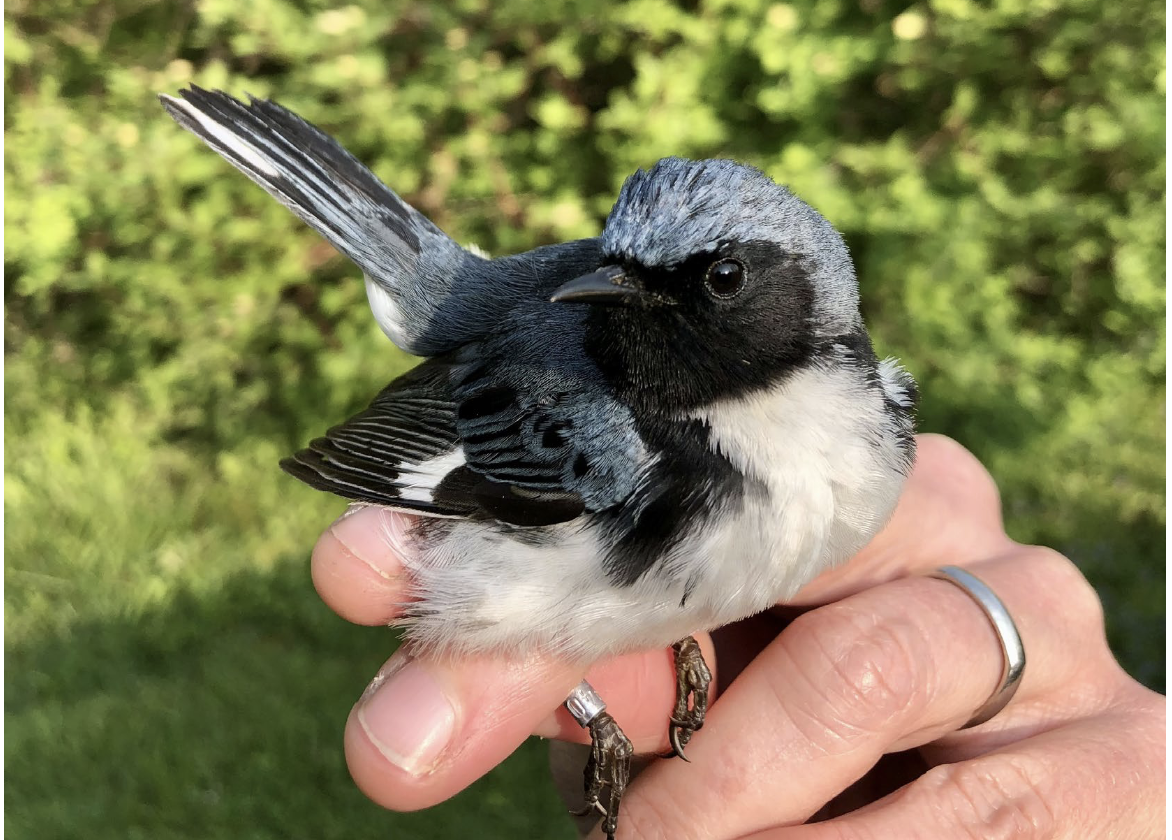Ornithology Exam 2
1/128
There's no tags or description
Looks like no tags are added yet.
Name | Mastery | Learn | Test | Matching | Spaced |
|---|
No study sessions yet.
129 Terms
Red Queen Principle (Coevolutionary arms race)
Constant evolutionary change is needed for an organism to maintain its fitness relative to the systems it is co-evolving with
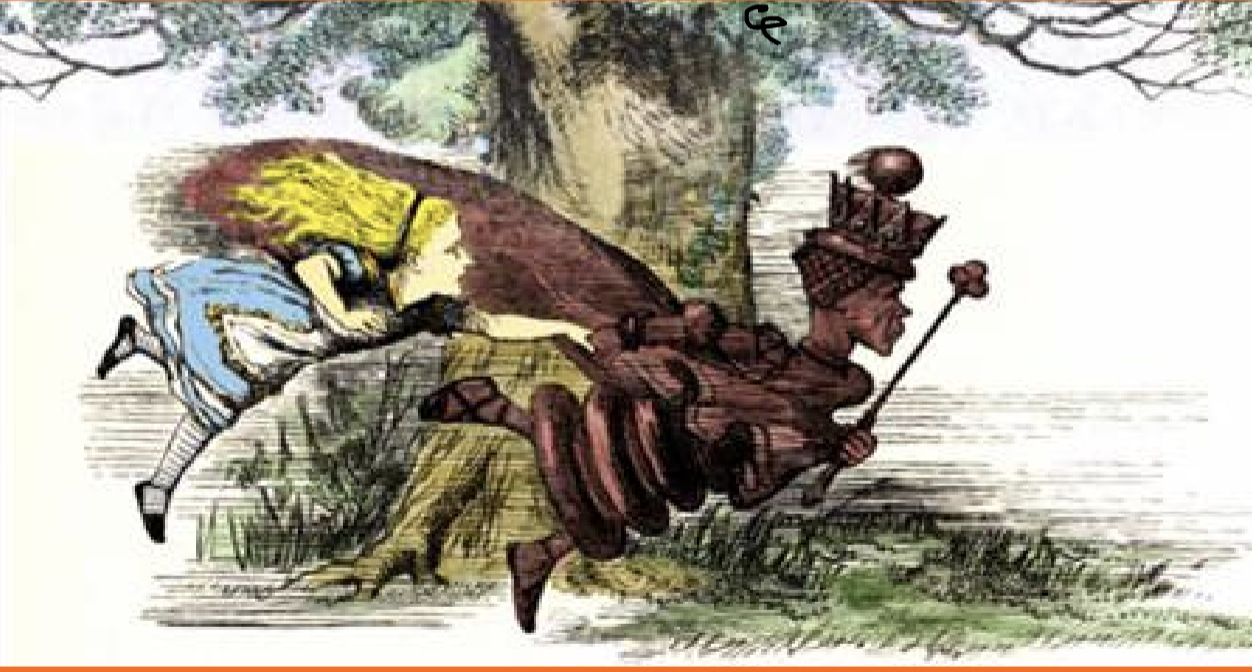
Crop
Enlarged portion of esophagus for temporary storage. Allows birds to transport food to nestlings and can produce crop milk.

Proventriculus
First stomach chamber which secretes digestive enzymes
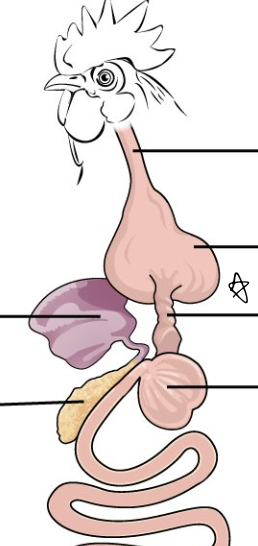
Gizzard
Muscular stomach for grinding
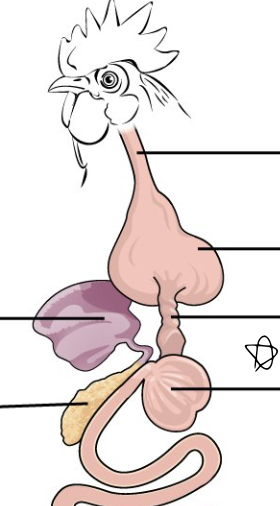
Optimal foraging theory
Natural selection favors individuals that exhibit foraging behaviors that optimize fitness. Animals should maximize energy intake per unit time spent foraging.
Factors contributing to optimal foraging theory
Choice of food type
Choice of where to feed (patch)
How much time to allocate to different patches
Pattern and movement speed during foraging
Functional response
Relationship between prey density and food consumption rate for a forager.
Marginal value theorem
Once forage begins foraging in a patch of food, the rate at which more food can be acquired slows down because there are fewer food items; creates diminishing returns. Foragers should stay in patch until rate of food intake is equal to the average rate of food intake across all nearby patches.
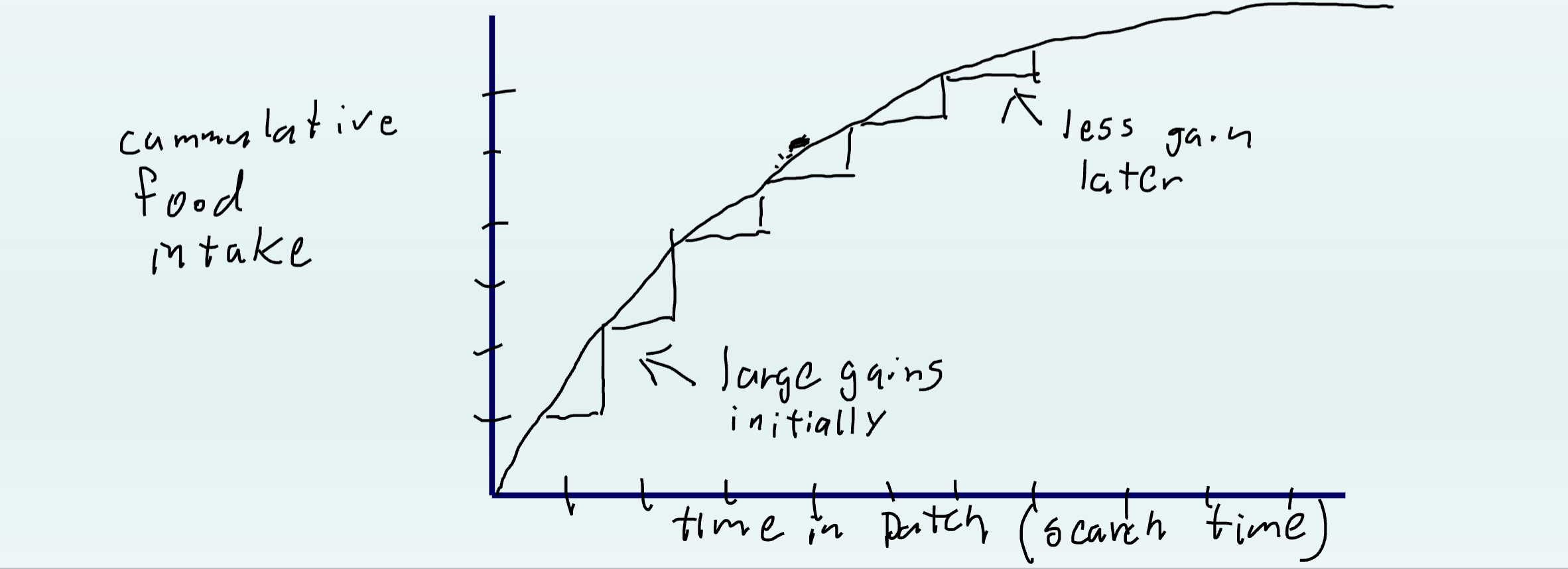
Patches and marginal value theorem
If there are greater distances between patches birds will wait for more food before relocating.

Evolutionarily stable strategy
A strategy that, if adopted by most of population, cannot be invaded or replaced by a different strategy through natural selection.
Game theory
Mathematical cost-benefit models involving alternative behavioral strategies or tactics allowing multiple strategies to be stable within a population over time. Alternative strategies maintained by negative frequency-dependent selection.
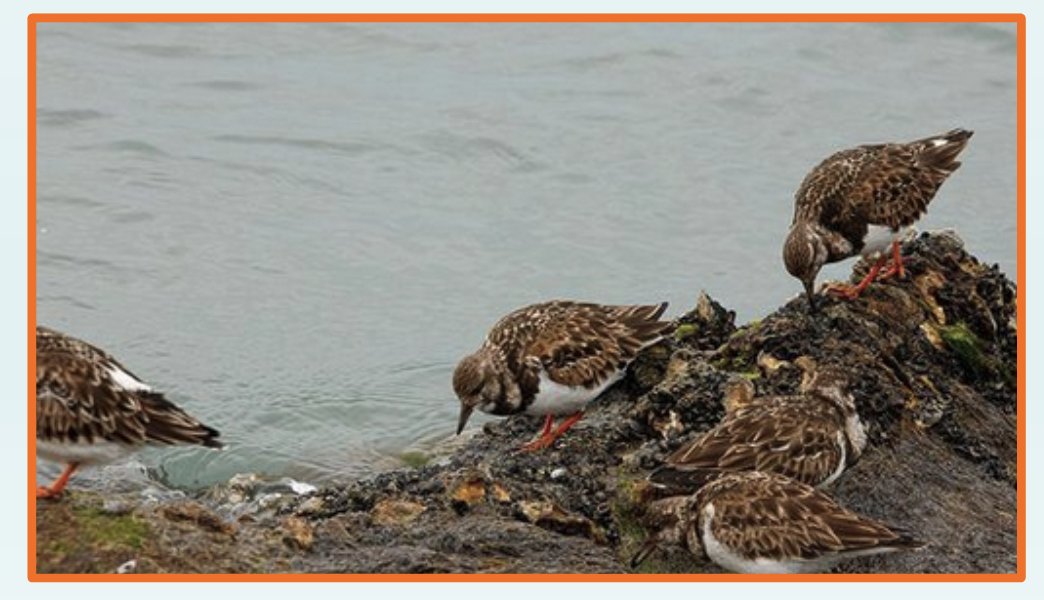
Negative frequency-dependent selection
As the frequency of a strategy within the population increases, its relative fitness goes down. Alternative strategies represent genetic polymorphism. Evolutionarily stable population will be at equilibrium frequencies f* and 1 - f*. At equilibrium the average fitness of strategies are equal.
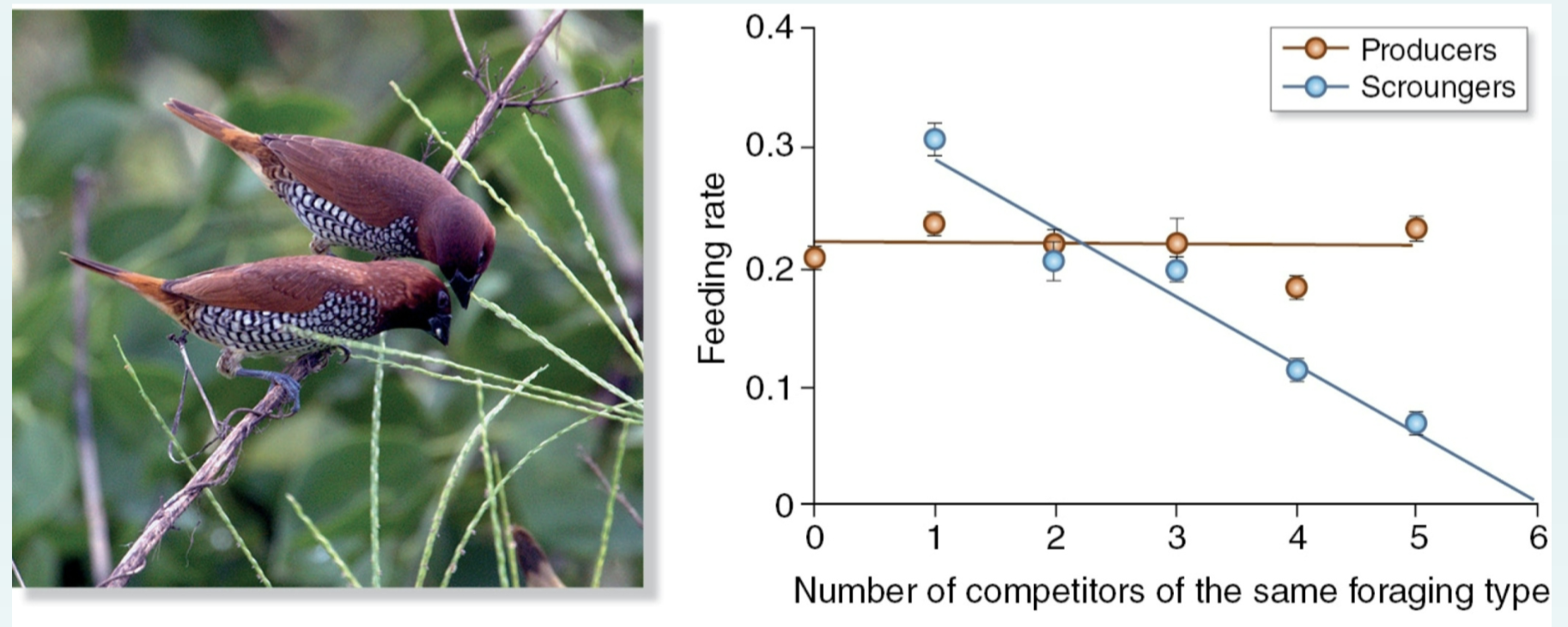
Conditional strategies
Strategy individuals choose depends on their condition (e.g., age, social status, health, population density). Selection has optimized the point at which individuals switch between strategies. Alternative strategies not necessarily due to simple genetic polymorphism. Fitness of alternative strategies are not always equal.

Woodpecker Finch
Use cactus thorns and twigs to pry insect larvae out of dead wood.
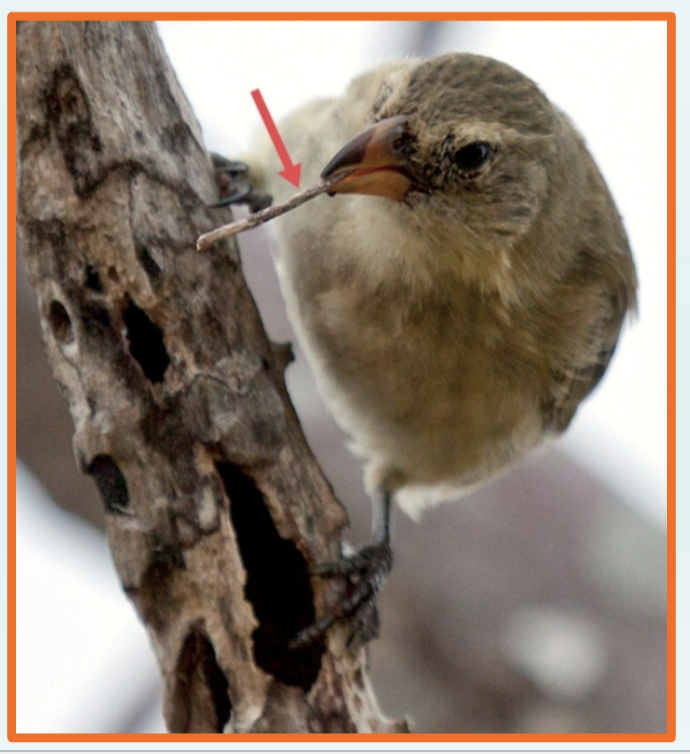
Egyptian vulture
Drop rocks to break open ostrich eggs
New Caledonian crow
Use palm fronds to fish out grubs; different cultural traditions of tool construction across island.
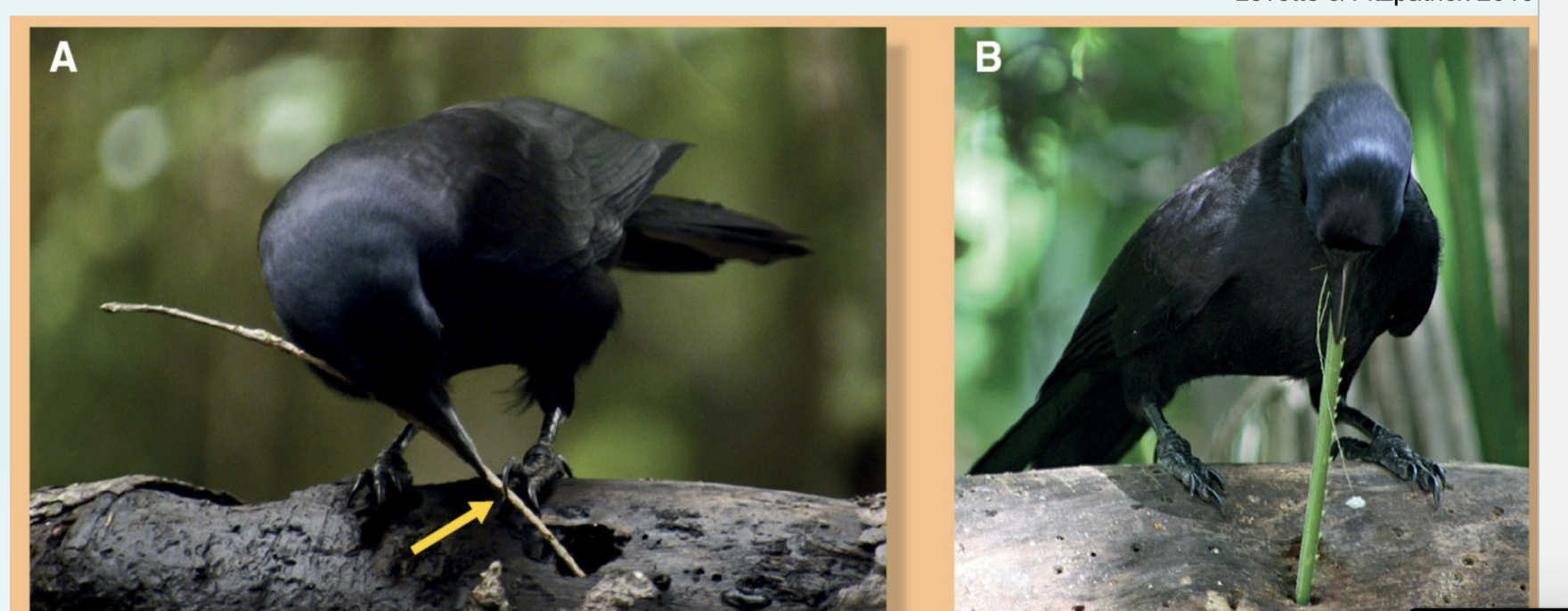
Sexual selection
A form of natural selection in which certain individuals have an advantage over others of the same sex and species in their ability to secure a mate.
Darwin’s observations on sexual selection
Male competition for mates
Females show choosiness
Selection has favored exaggerated male traits
Parental Investment
Any effort that raises offspring survival at the expense of the parents ability to support other offspring.
Sex with largest becomes limiting resource.
Why do females usually have higher parental investment?
Eggs are more costly to produce than sperm
Internal fertilization means males are less certain of parentage
How can males increase potential rate of reproduction?
Reduced parental investment
Operational sex ration (OSR)
Ratio of potentially breeding males to fertilizable females. Higher ration leads to stronger selection on males (>1)
Leads to higher OSR
Larger male population
Asynchronous breeding
Clumped female distribution

Leads to strong selection on male traits
High OSR leads to high variance in reproductive success for males.

Intrasexual selection
Competition between members of same sex for access to mates (usually between males)
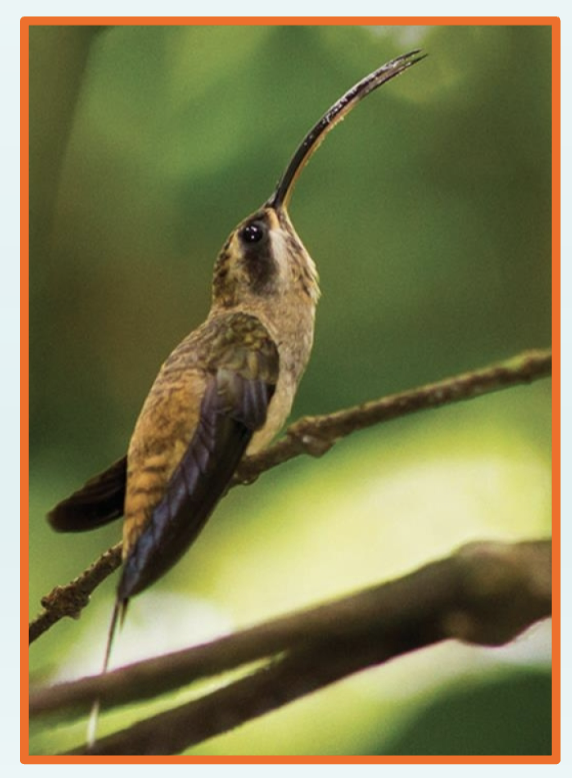
Contest competition
Intrasexual selection that favors traits that improve success in direct interactions: larger body size, weaponry, threat signals.
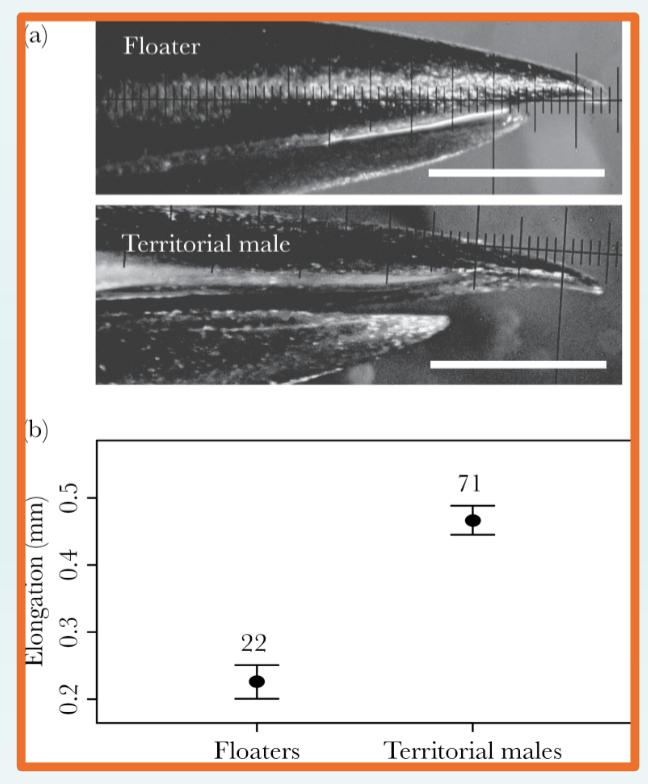
Scramble competition
Intrasexual selection that favors traits that improve ability to rapidly and accurately locate mates: perceptiveness, mobility, spatial memory.
Sperm competition
Intrasexual selection involving post-copulatory competition to fertilize eggs. Favors high quality sperm and mate guarding.
Direct benefits of female choice (intersexual selection)
Material benefits to female or her offspring including parental care, nuptial gifts, and better mate health.
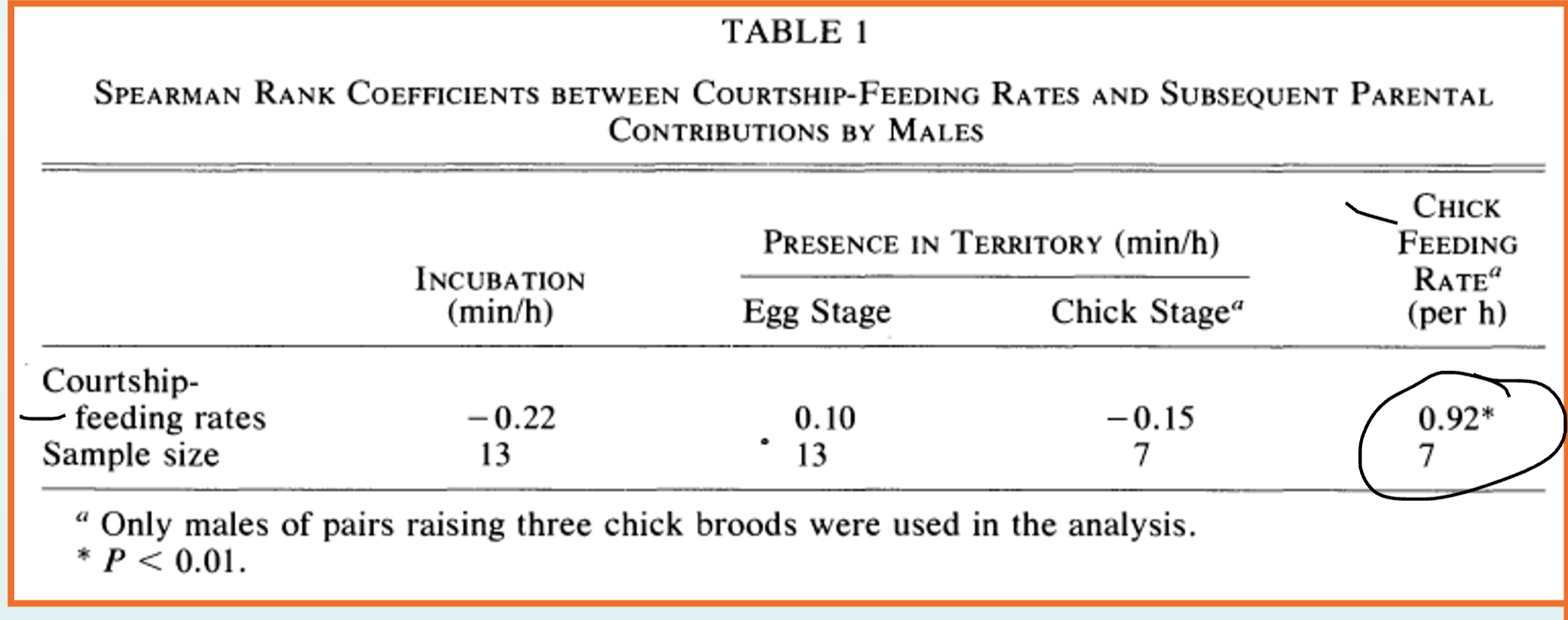
Indicator mechanisms in female choice (intersexual selection)
Indirect: Good genes hypothesis —> offspring inherit viability genes.
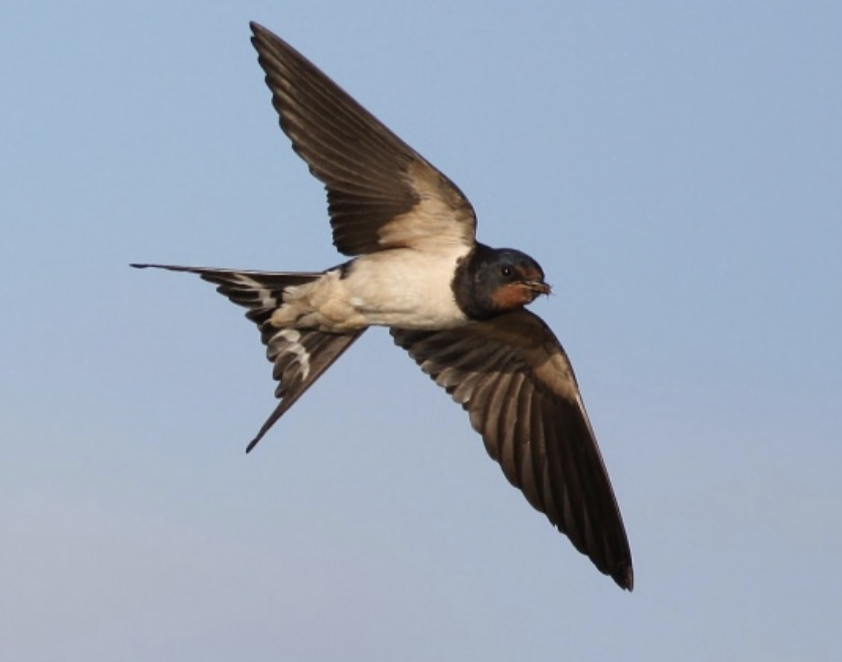
Runaway selection in female choice (intersexual selection)
Indirect: Sexy sons hypothesis —> Males inherit traits that make them more attractive to females.
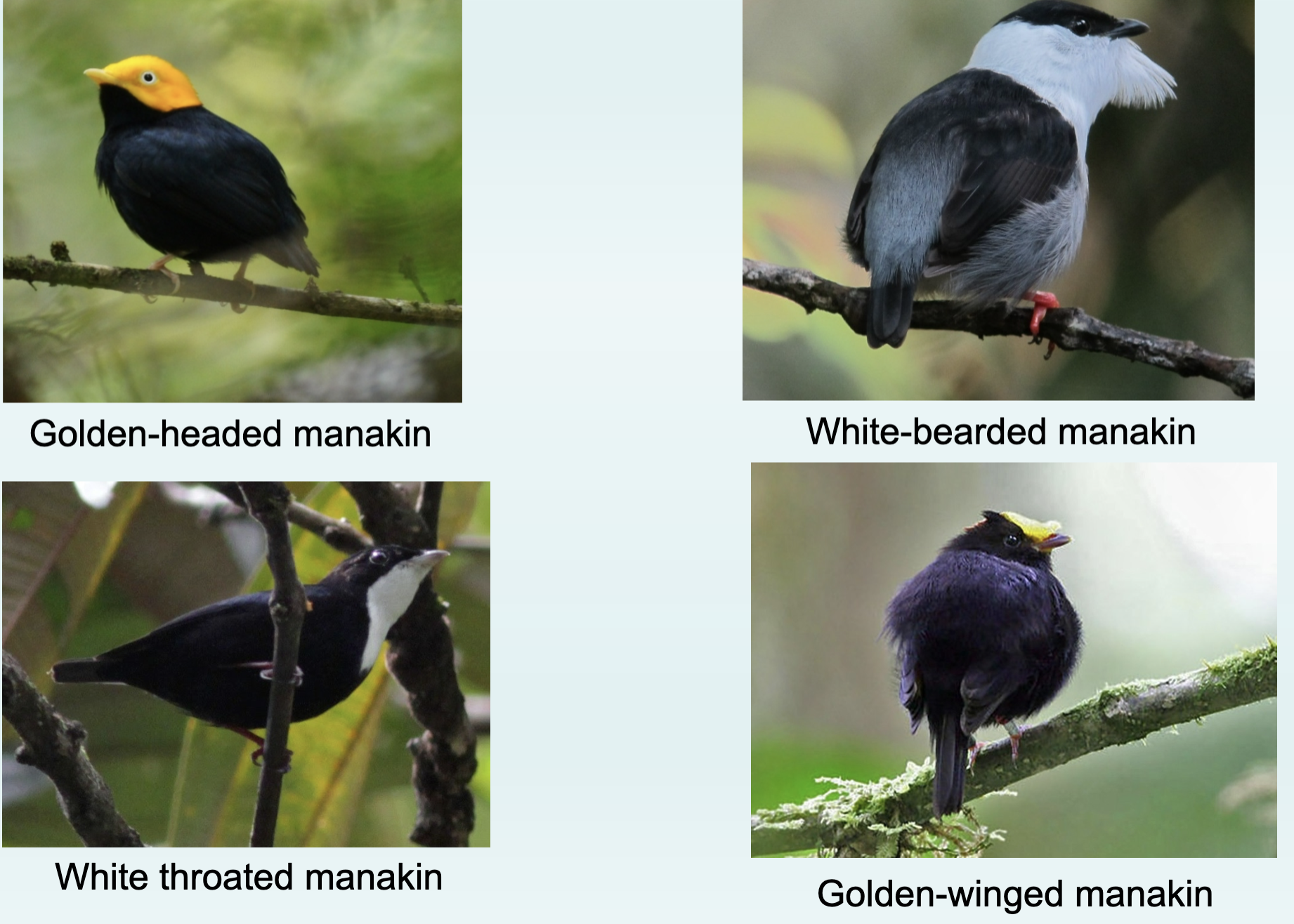
Chase-away selection (intersexual selection)
Co-evolution of mate persistence and female resistance traits driven by sexual conflict.
Examples of indicator mechanisms
Conspicuous or costly trait provides an indicator of male condition and associated with viability genes.
Trait is an honest indicator of male condition because low quality mates cannot express the indicator.
Females that mate with males having the indicator trait will produce sons and daughters with greater survival.
Both the traits and the preference are passed down to next generation.
Advantages of indicators over runaway selection
Allows for costly female choice
Costs of preferred male trait are balanced by indirect fitness benefits to all offspring.
Hamilton-Zuk Hypothesis
Genetic cycles in hosts and parasites maintain heritability of traits for disease resistance
Animals choose mates with genetic disease resistance based on condition-dependent indicator traits
Supported by more elaborate secondary sex traits higher in birds species with higher parasite loeads
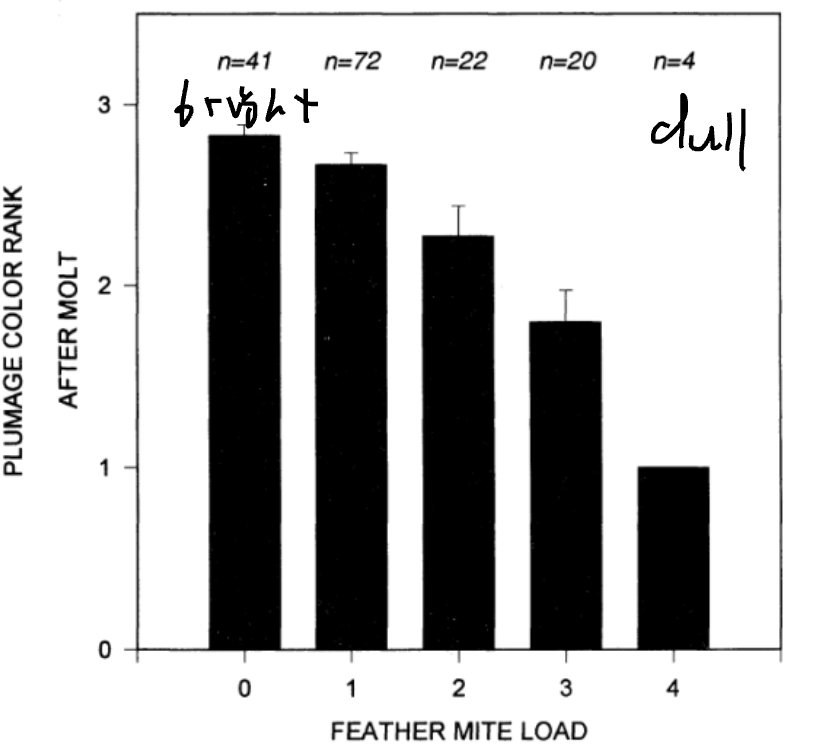
Bowers
Structures used as mating sites, more complex structures preferred.

Runaway selection process
Male trait initially correlated with fitness
Females prefer these males and offspring have higher fitness
Genes for female preference and male traits passed on
Male with trait will gain additional sexual selection as female preference also strengthens
This process self reinforces and traits are exaggerated. Decouples from survival selection
Eventually survival selection will counter sexual selection benefit
Prediction of runaway hypothesis
Runaway selection favors exaggeration of arbitrary traits.
Sexual Conflict
Conflict between the evolutionary interests of the two sexes. Arise due to differences in parental investment.

Examples of chase-away selection
Sexually antagonistic co-evolution of traits. Traits that increase male mating success and decrease female mating success.
Song Development Experiment
Isolated chicks show abnormal song
Exposed to recordings of parent showed normal song
Chicks deafened after exposure showed abnormal song
Chicks exposed to other species song showed abnormal parent species song

Critical Period
Early period of development when bird’s brain selectively stores species-specific song
Sub-songs
Incomplete plastic versions of full song used during plastic period at older age. Bird compares its own song against the song it remembers from critical period.
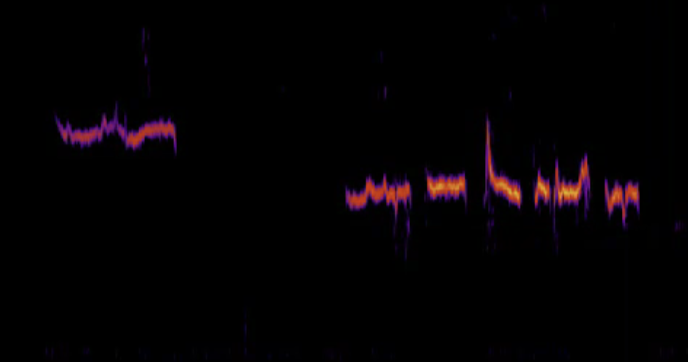
Full song
Crystallized song that is practiced repeatedly and becomes “fixed” in adult bird (but is not fully fixed).

Song Learning
Social interactions within species critical for song learning (but not mimics). Learning evolved independently in passerines/parrots, and hummingbirds.
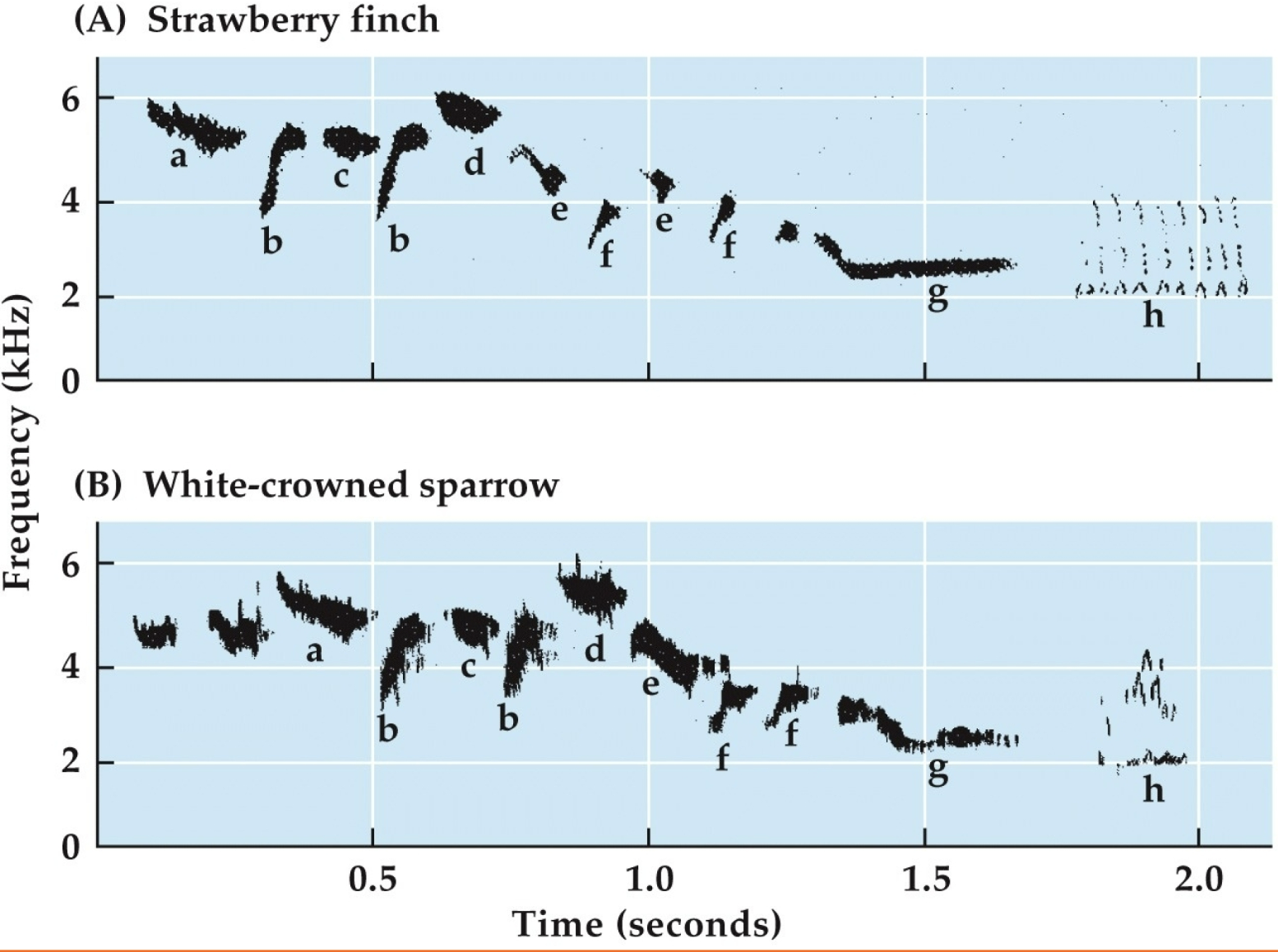
HVC size
Song learning does not cause HVC to grow, larger HVC is needed to learn maximum # of songs.
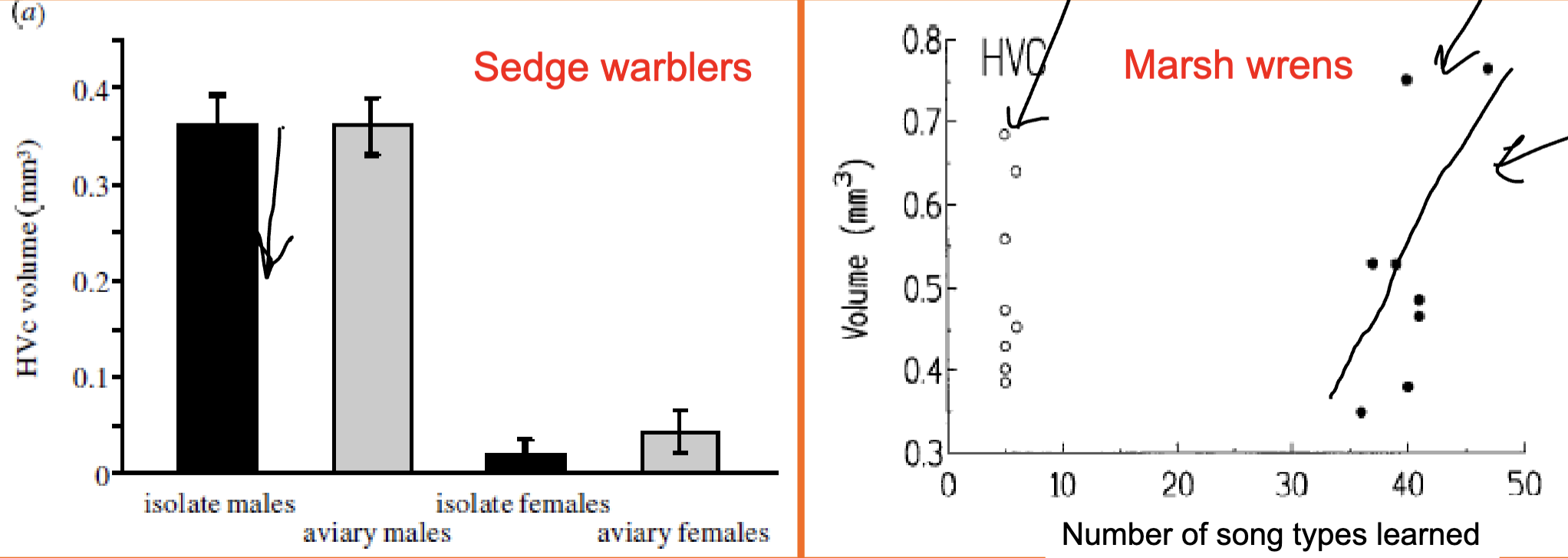
Territorial song responses
Stronger response to local songs, even with minimal genetic differences. Birds match the song of their neighborhood over birth location.
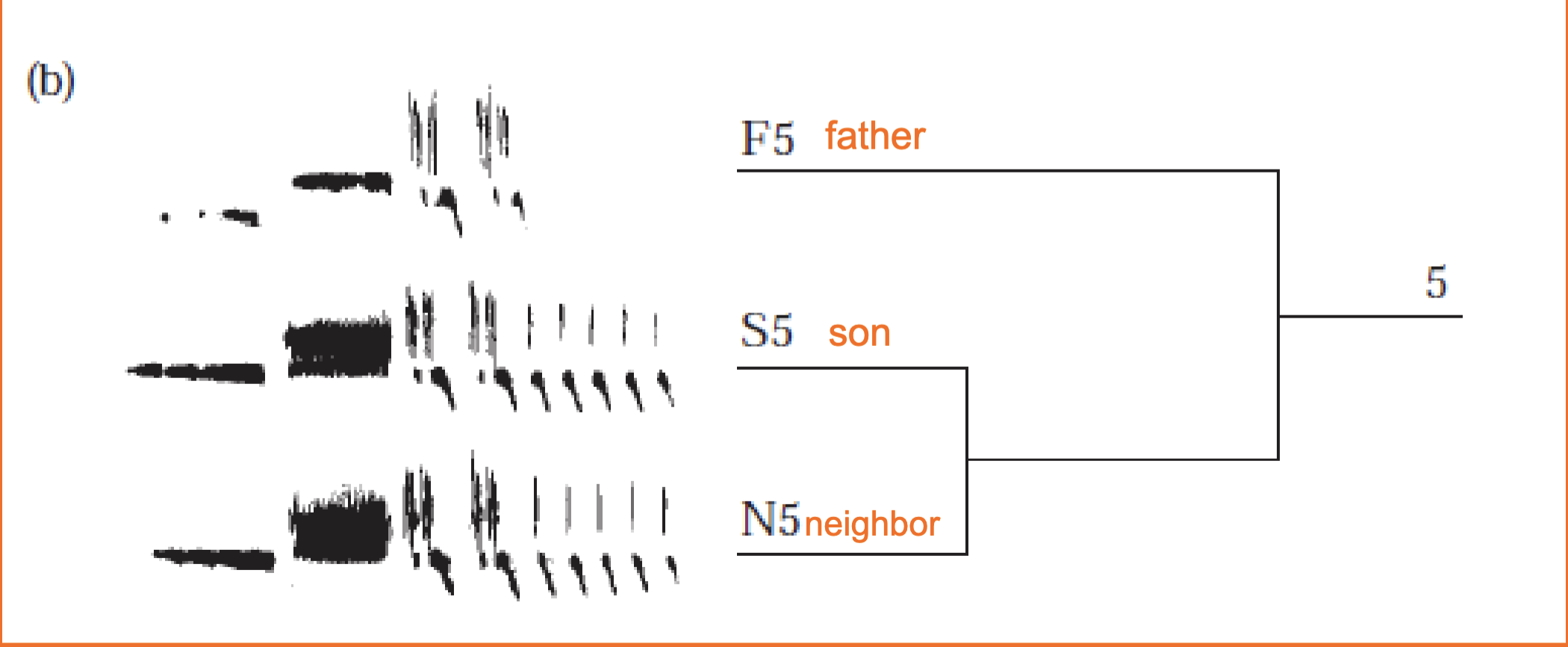
Dear enemy effect
Tendency among territorial animals to show less aggression towards familiar neighbors than strangers, depending on location of enemy.
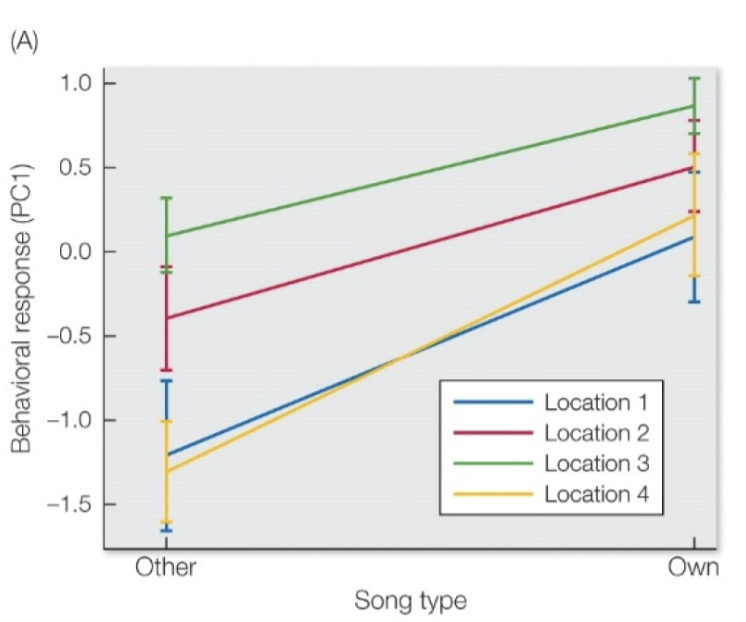
Matched counter-singing
Rival males respond to one another’s song by matching the other male’s song type. Can be used to escalate or de-escalate aggression, dependent on species.

Female-choice hypothesis
Females preferentially mate with males with more complex song repertoire.

Honest Signal
trait correlated with fitness (eg. body condition with repertoire size in song sparrows)
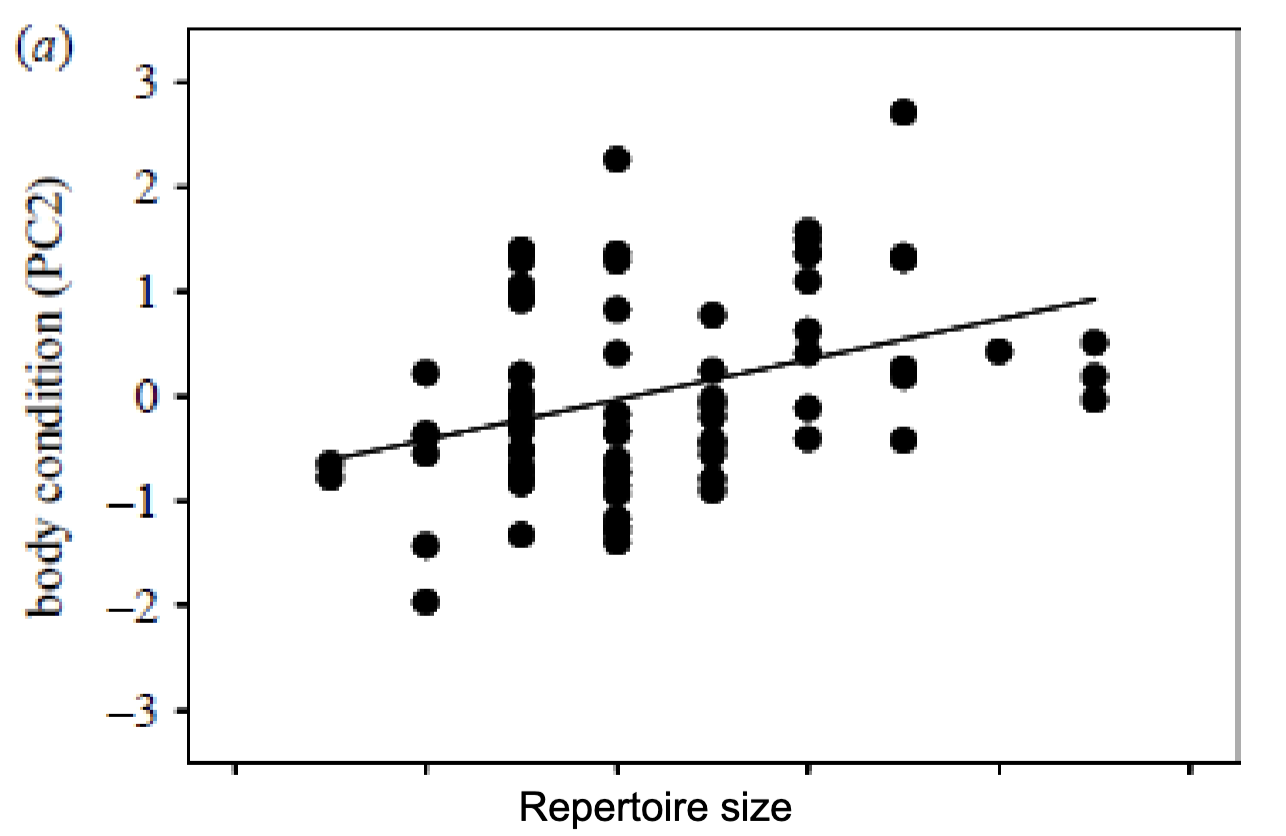
Dawn chorus
beginning about an hour before dusk, most day-active birds begin to sing. It is the quietest time of day with few predators and a good time to check in with nearby birds.
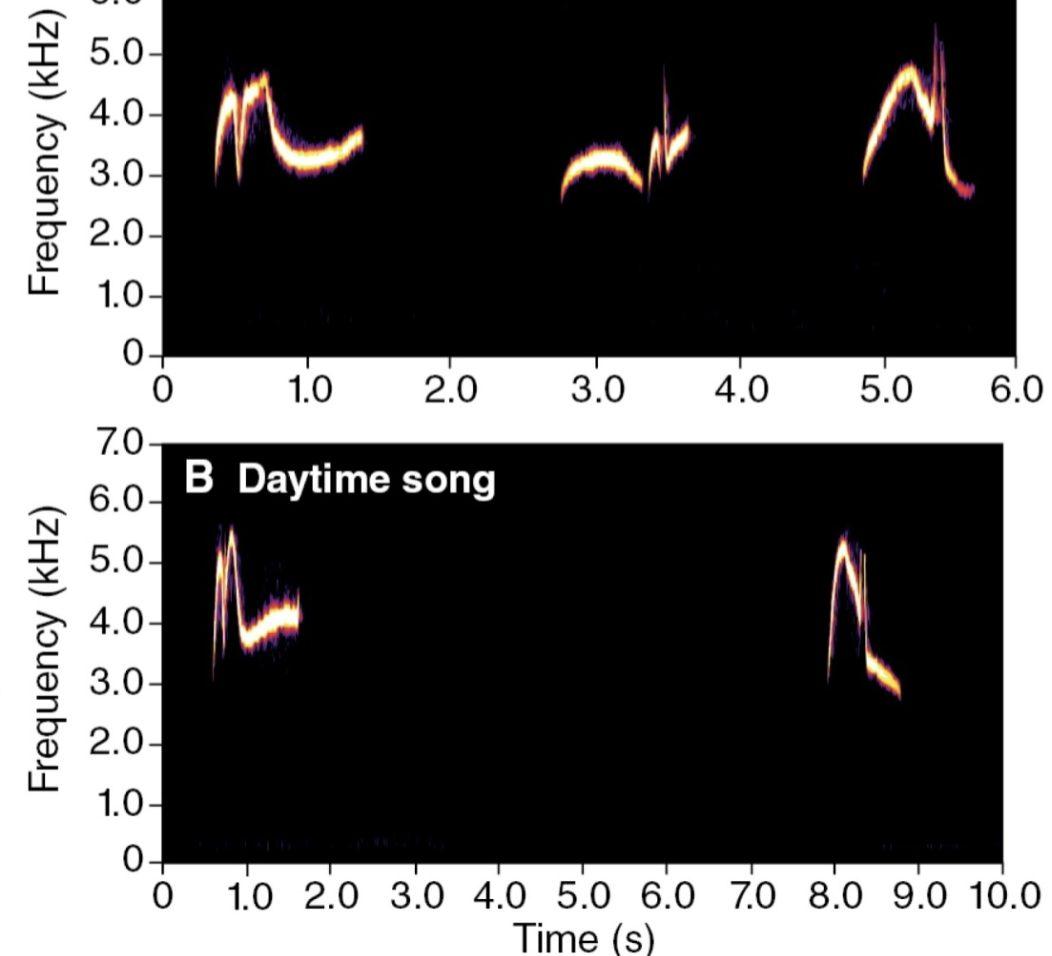
Ultimate questions
Explain why a particular trait evolved focusing on evolutionary origin and benefit of a trait.
Proximate Questions
Explain how a particular trait is expressed in development, physiology, and genetics
Oscillogram
Sound intensity plotted against time

Sonogram (Spectrogram)
Sound frequency plotted against time, loudness may be represented by color

Vocal signal
Vocalization that influences the behavior of another individual

Song
Often loud and complex vocalization used to attract mates and/or compete with the same sex
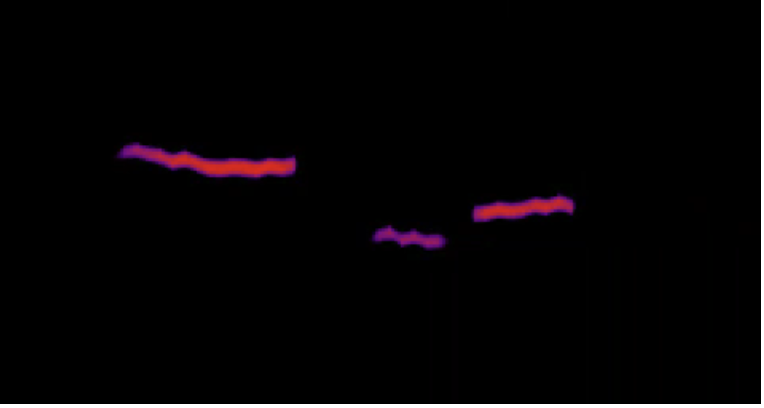
Functions of bird vocalizations
Territorial defense
Begging calls of chicks
Flock cohesion and coordination
Deception; scare away others from food
Alarm; warn when a predator is approaching
Mobbing call; encourage other birds to attack a predator
Mate attraction
Syrinx
Primary sound-producing organ for birds, located at the point where the trachea divides into two bronchi
Flaps of tissue (labia) vibrate when air passes over them
Constriction of labia is regulated by 6 pairs of muscles
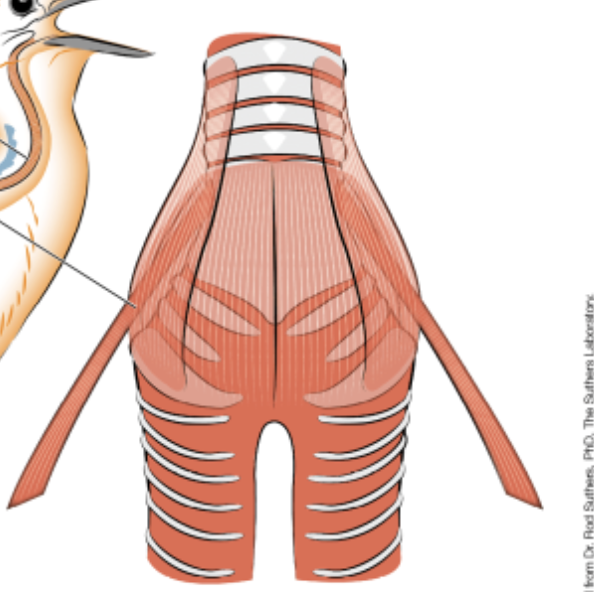
Nucleus
Cluster of neuron cell bodies in brain with similar function
High vocal center
Required for bird song production and learning
Larger in bird species with a larger repertoire
Output to RA and Area X
Grows during breeding season.
Robust Nucleus of archistriatum
Required for song production
Input from HVC and output to nXIIts
Sexually dimorphic in most songbirds
Hypoglossal nucleus (nXIIts)
Required for song production
nucleus of cranial nerve #12 sends a motor signal to syrinx
Recursive loop
Activated during learning: HVC —> Area X —> DLM —> RA
Anatomy of bird song
Early sensory input influences gene expression in sexually dimorphic brain regions
ZENK gene
Produces transcription factor that leads to increased neural connectivity in brain
Increases during song learning
More active during singing and listening
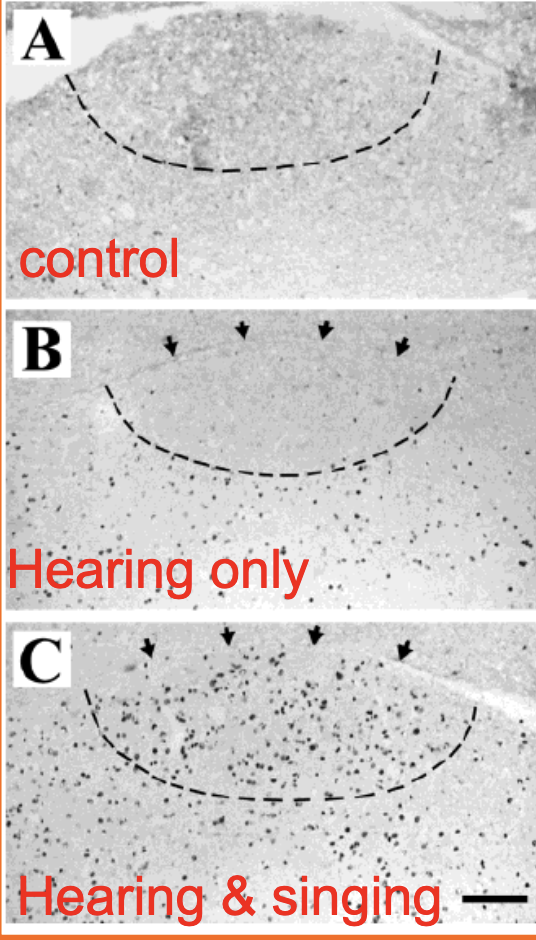
Why do birds migrate?
Seasonal resource availability
Avoiding harsh conditions
Breeding success and availability of nest sites
Avoidance of predators and pests
Energetic tradeoffs with surviving harsh environments
Northern home hypothesis
Birds started migrating from their temperate breeding range to the tropics for the off season to avoid harsh conditions (more common hypothesis)
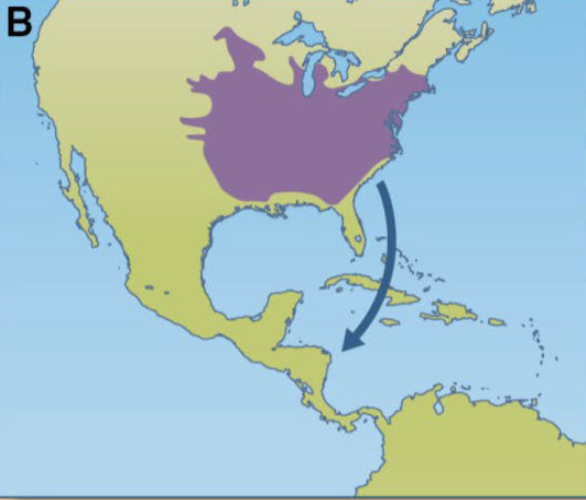
Southern hypothesis
Birds started migrating from tropical home to temperate breeding sites to avoid competition in dense tropics (less common hypothesis)
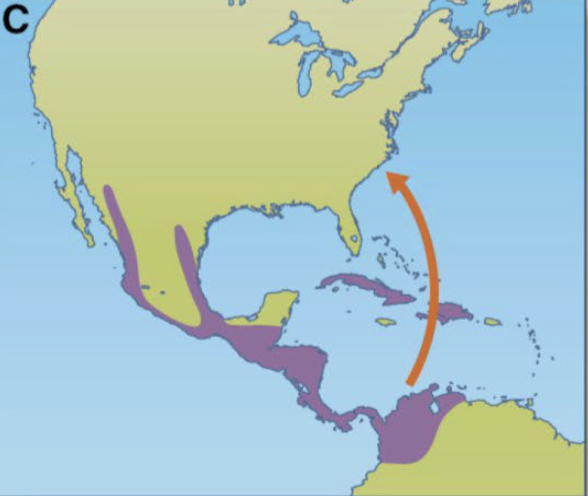
Migration
Seasonal two-way movements that bring individuals between breeding and non-breeding sites
Dispersal
The movement of an individual from one breeding site (including site of birth) to another
Residence
Migration strategy 1: No migration
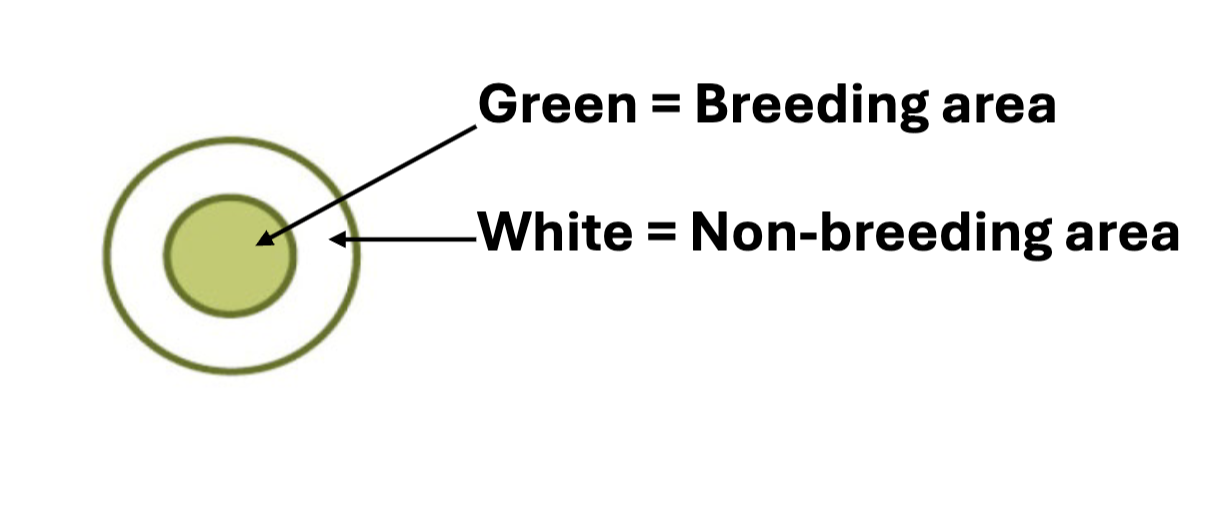
Obligate Migration
Migration strategy 2: Individuals migrate to the same area along the same schedule every year

Facultative Migration
Migration strategy 3: The timing and distance of migration changes each year in response to varying environmental conditions
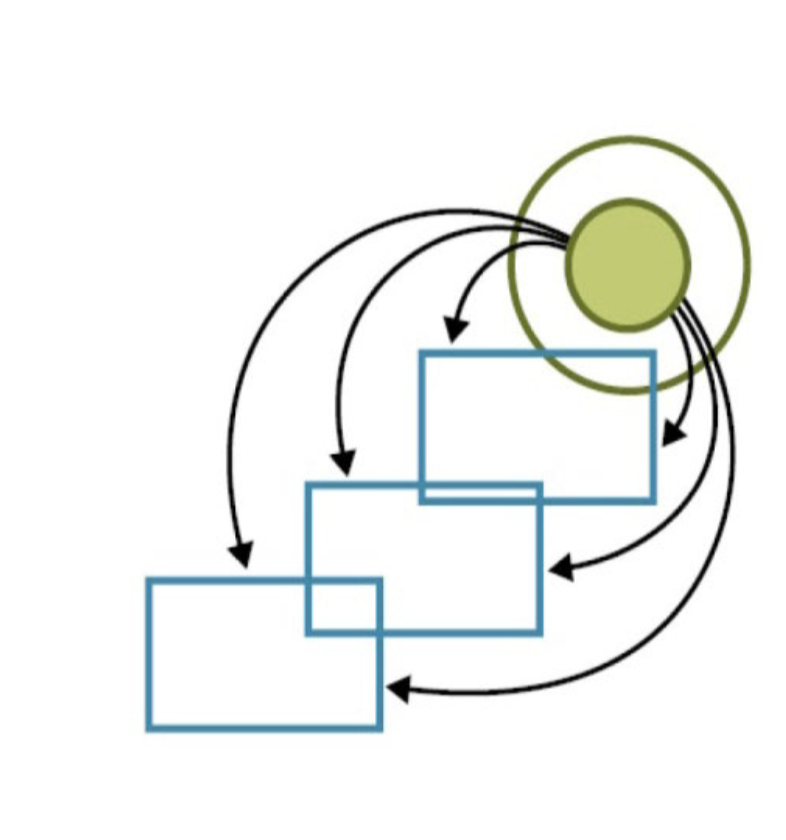
Irruptive migration
Type of facultative migration involving movement in large numbers beyond typical range, usual in response to low food supply
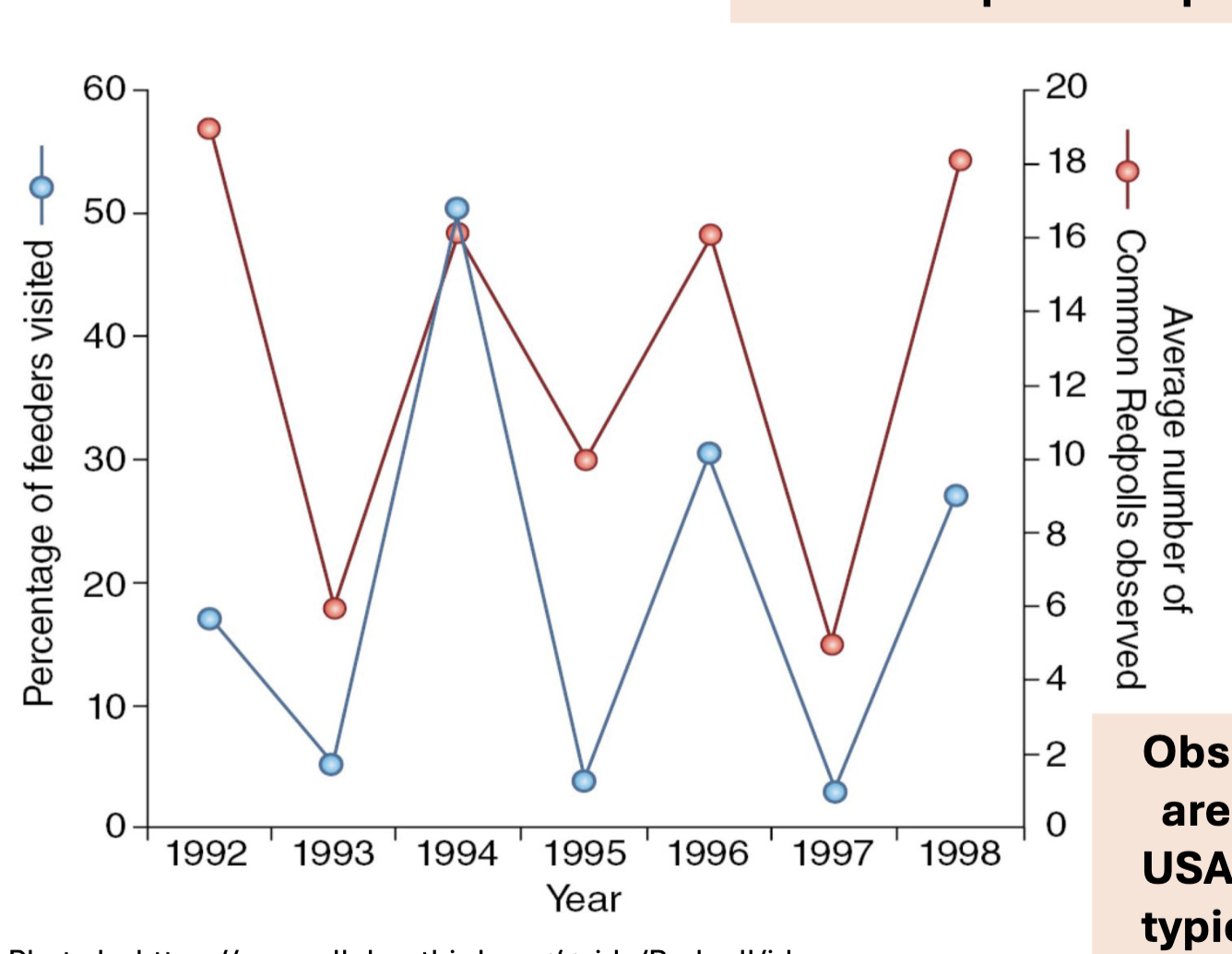
Partial migration
Type of facultative migration involving some species within a population migrating while others do not
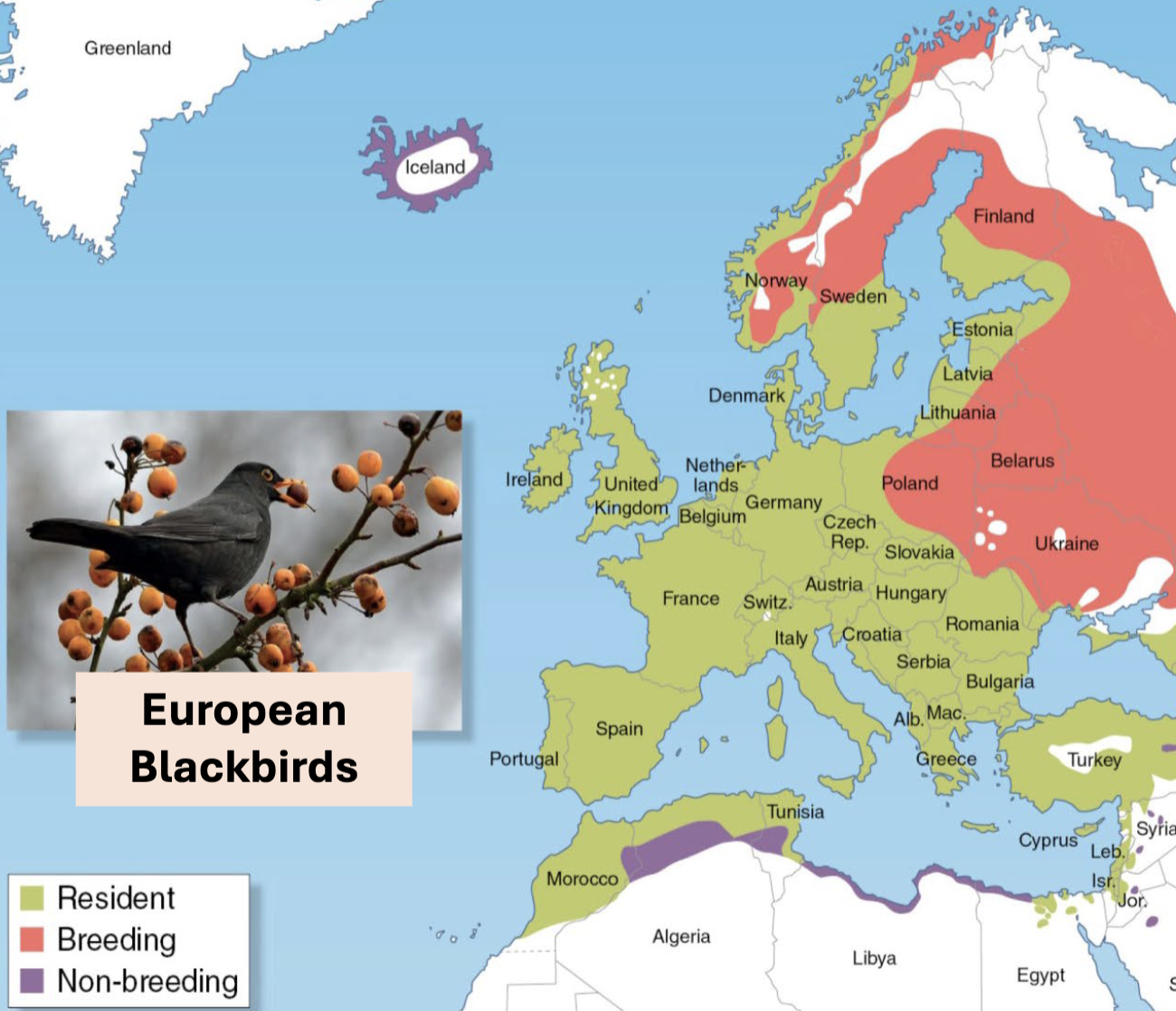
Leapfrog migration
Type of facultative migration where the farthest North individuals migrate to the farthest South sites
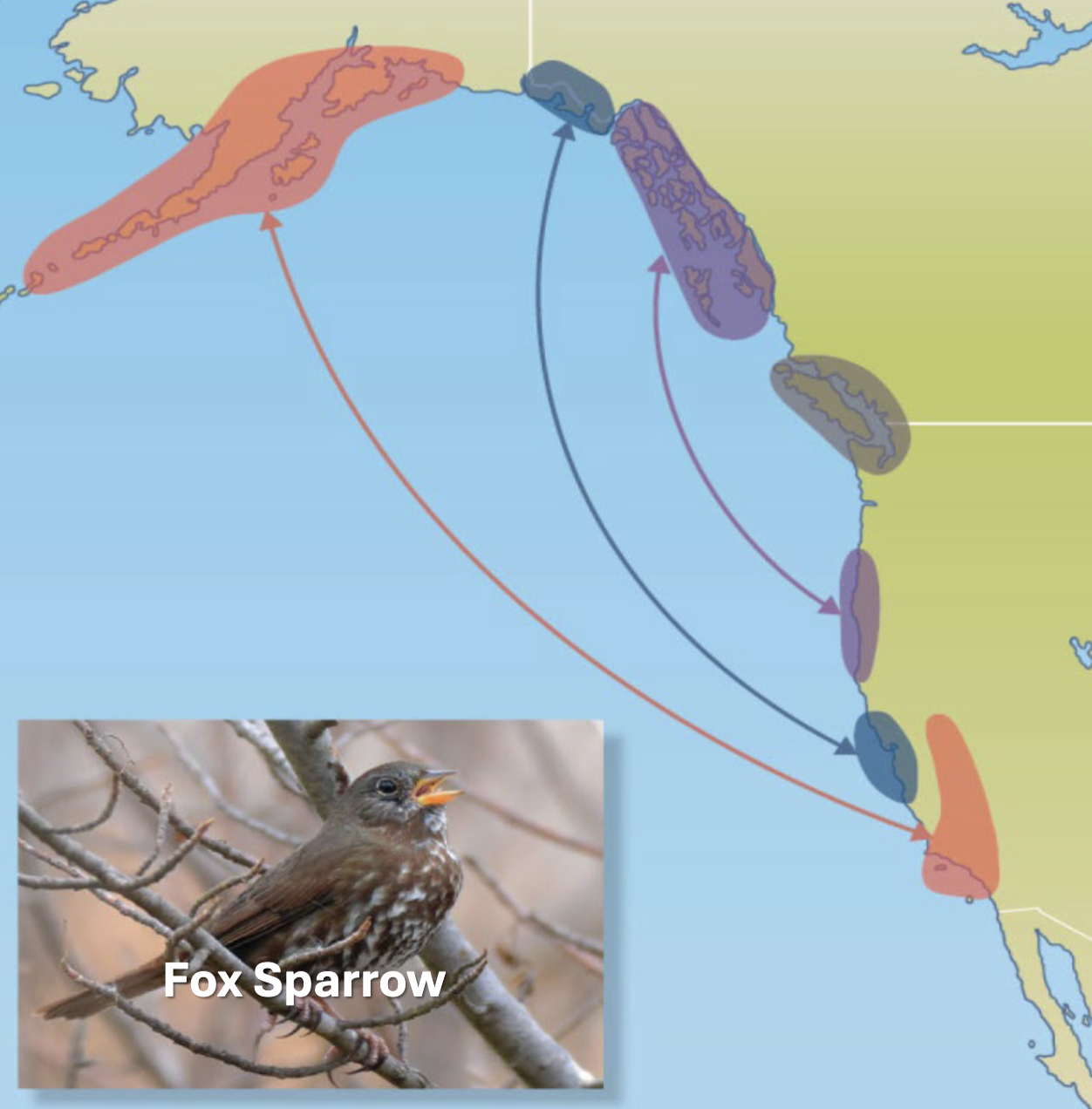
Nomadism
Migration strategy 4: Birds move irregularly in response to highly variable food and environmental conditions
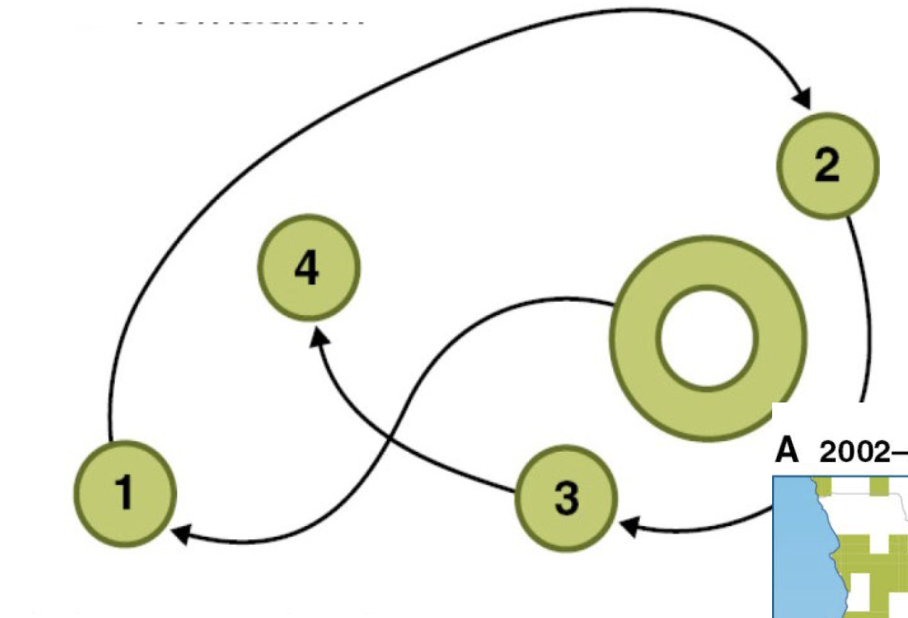
Zugunruhe
Migration restlessness
What triggers migration?
Photoperiod: the relative length of light and dark periods of the day
Internal clocks
Changing photoperiod changes molt and breeding cycles
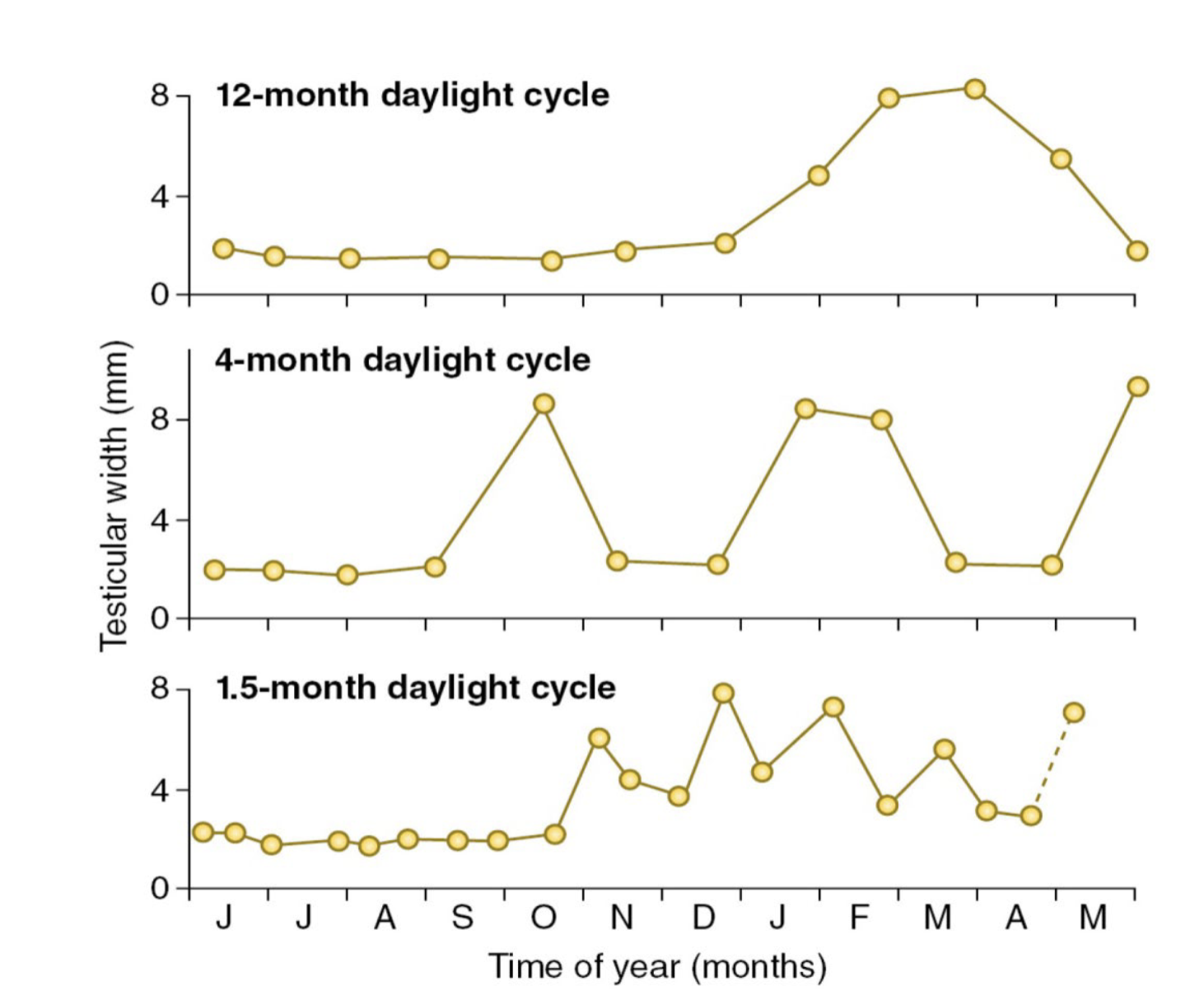
Migrational timing
Spring: Older males migrate first, females and second year birds come a bit later
Fall: Adults often leave before hatch-year birds
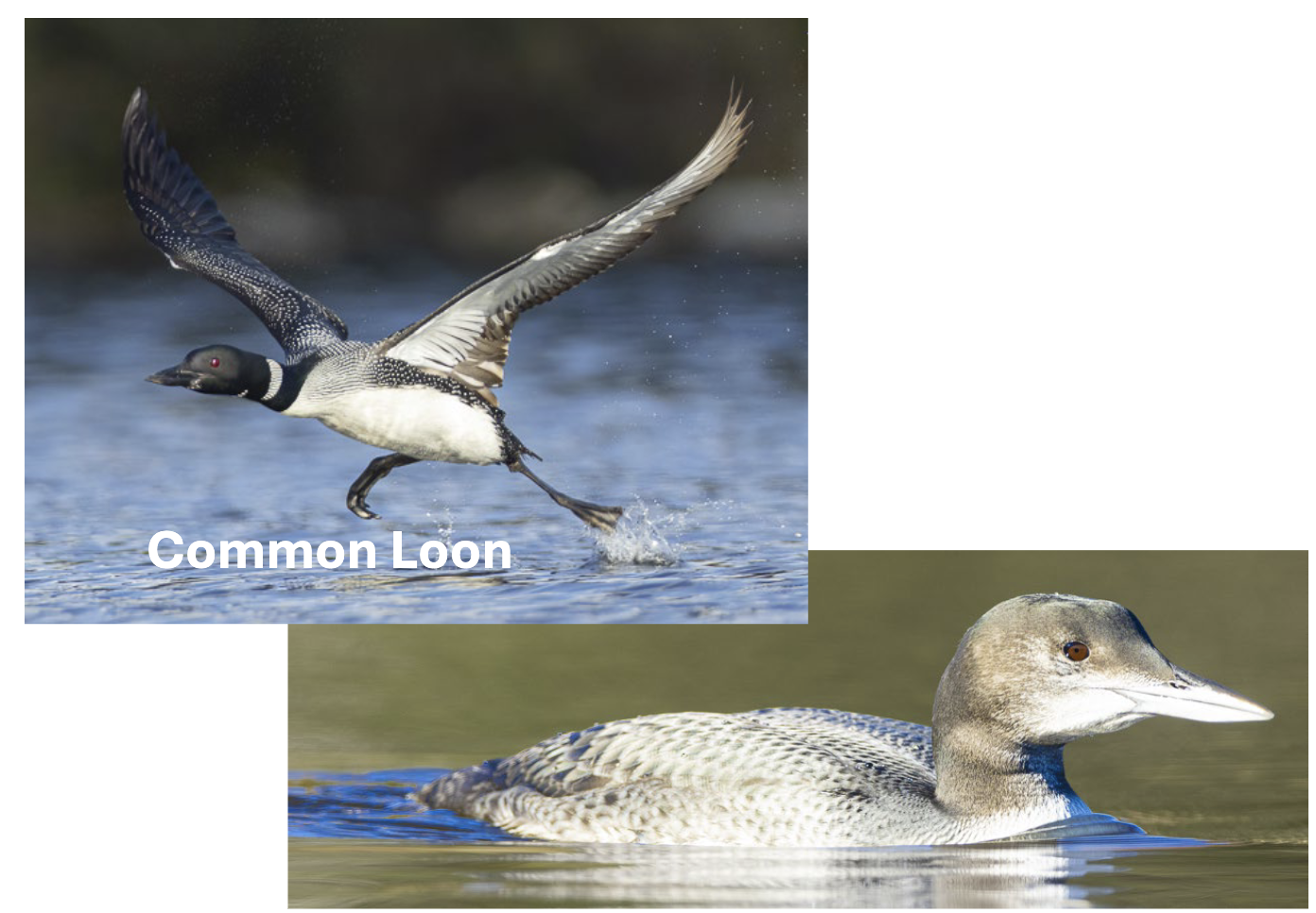
Hyperphagia
Increase in appetite as migration approaches. Fat fuels migration
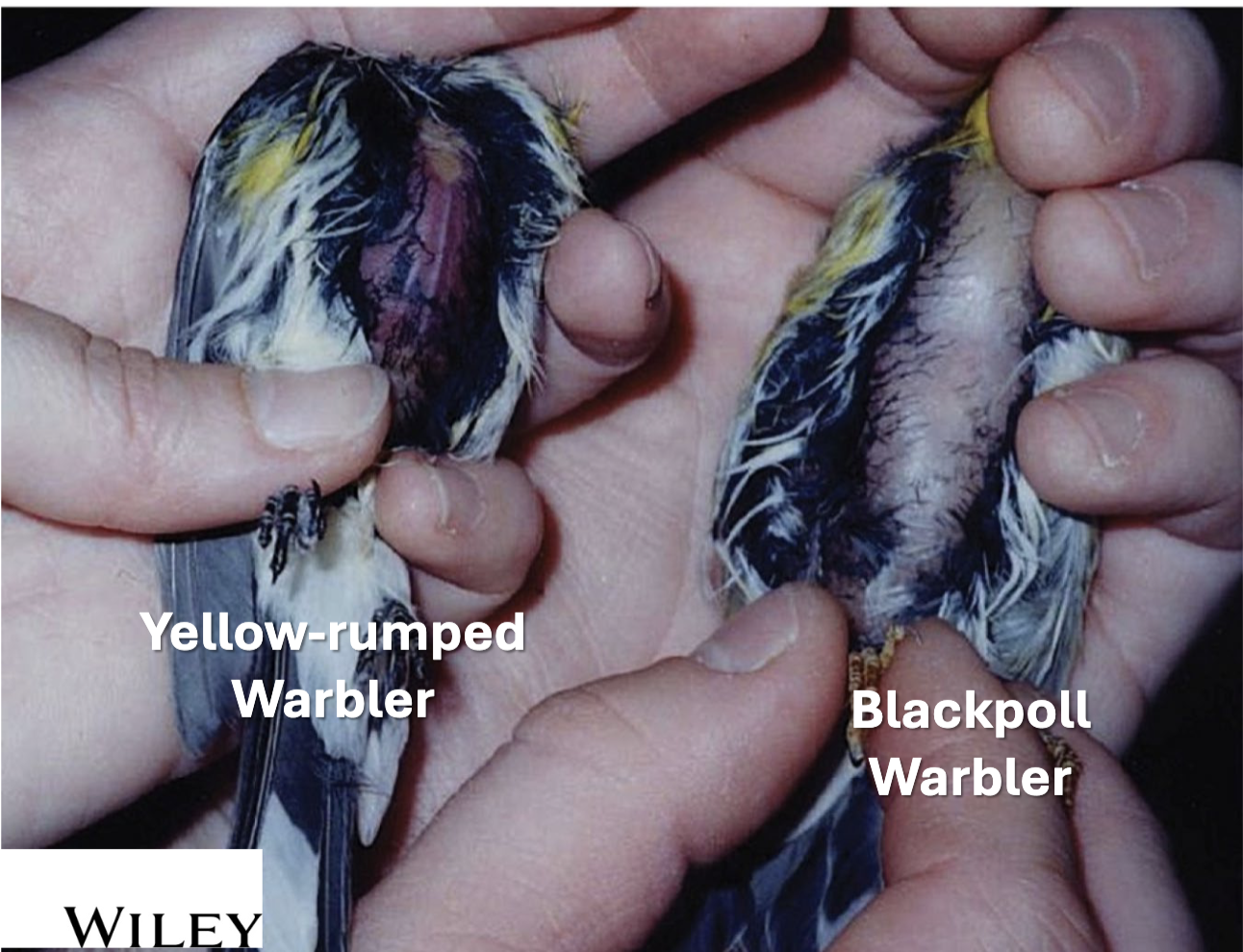
Physiological migration changes
Stomach and intestines increase in size
Liver becomes 2-3 times larger
Change in enzymes
Then organs shrink before flight
Magnetic perception
Magnetite in upper mandible of bill that may help with navigation. Birds can probably see magnetic fields.
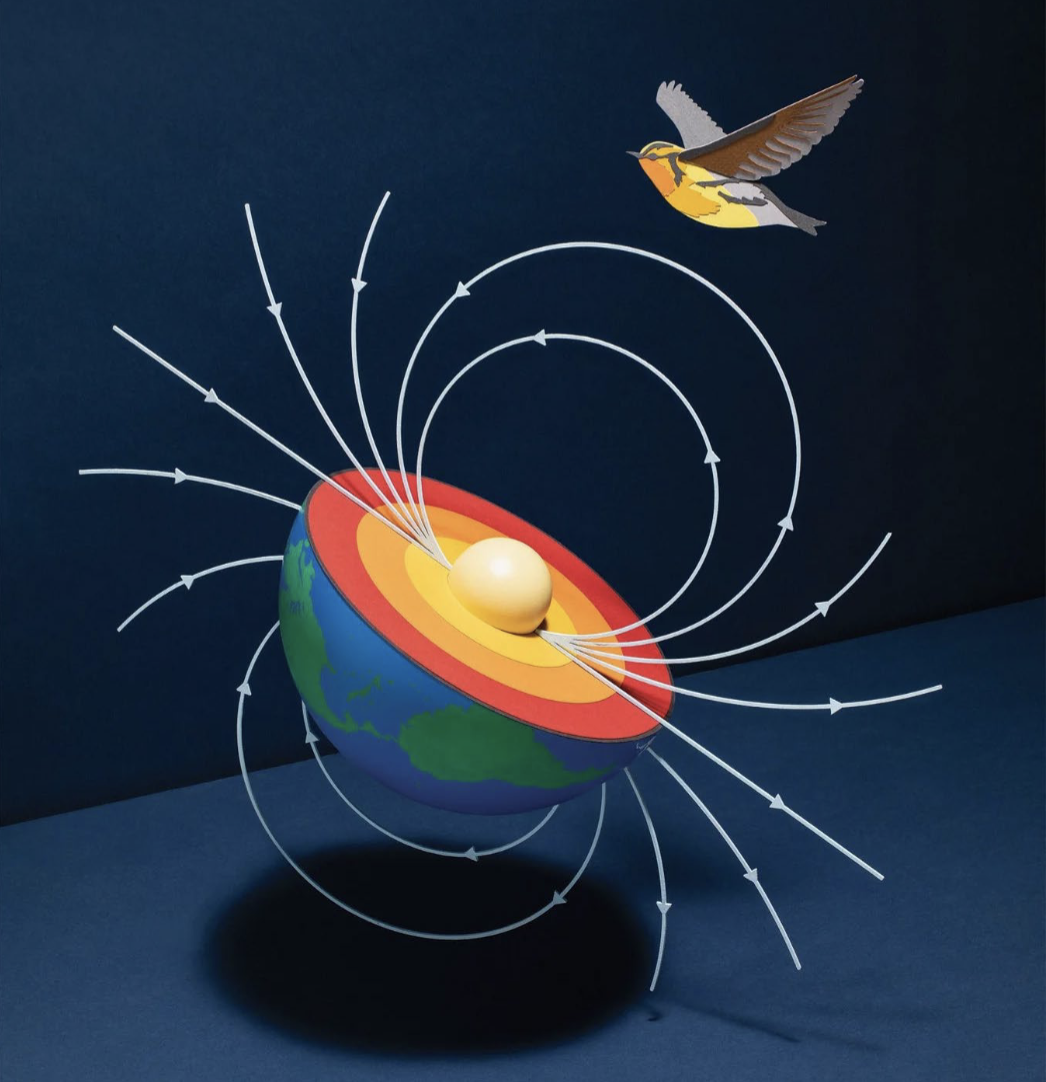
Solar cues
Changes in the sun throughout the day, throughout the year, and by latitude can help with navigation

Landmark navigation
Use of coastlines, mountains, rivers, and other visual cues in navigation

Celestial navigation
Use of stars and their rotations to navigate when migrating at night

Genetic navigation
Variation in species on where to migrate in genetically distinct groups

Philopatry
Tendency to return to the same location year after year

Dispersal timing
May occur post fledge (robin), pre-migration (loon), or post-migration (goose)

Dispersal Distance
Most species stay close to birth sites, with females dispersing farther than males

Land migration
Raptors and other species that migrate over continents
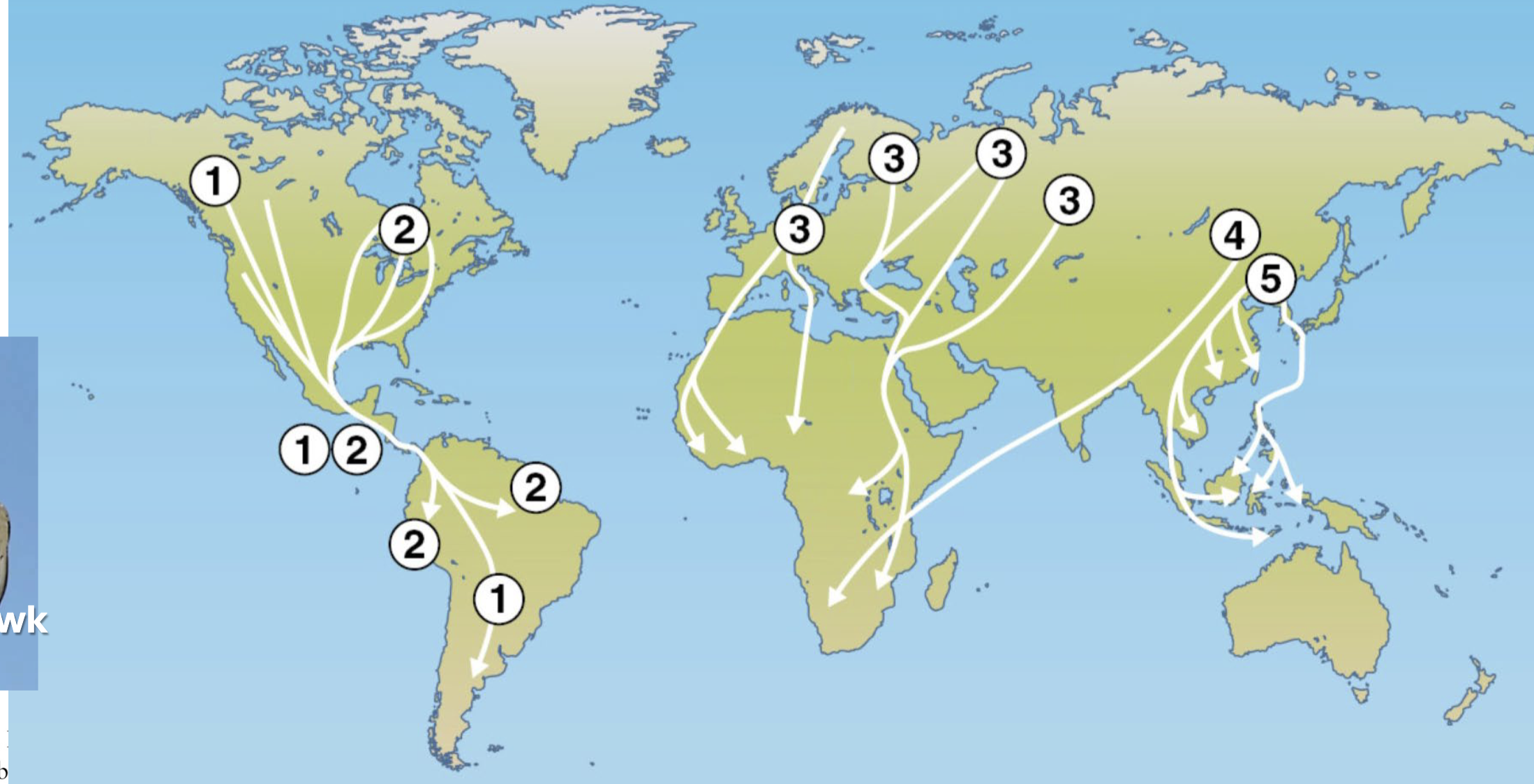
Over sea migration
Passerines and other species often cross over bodies of water during migration
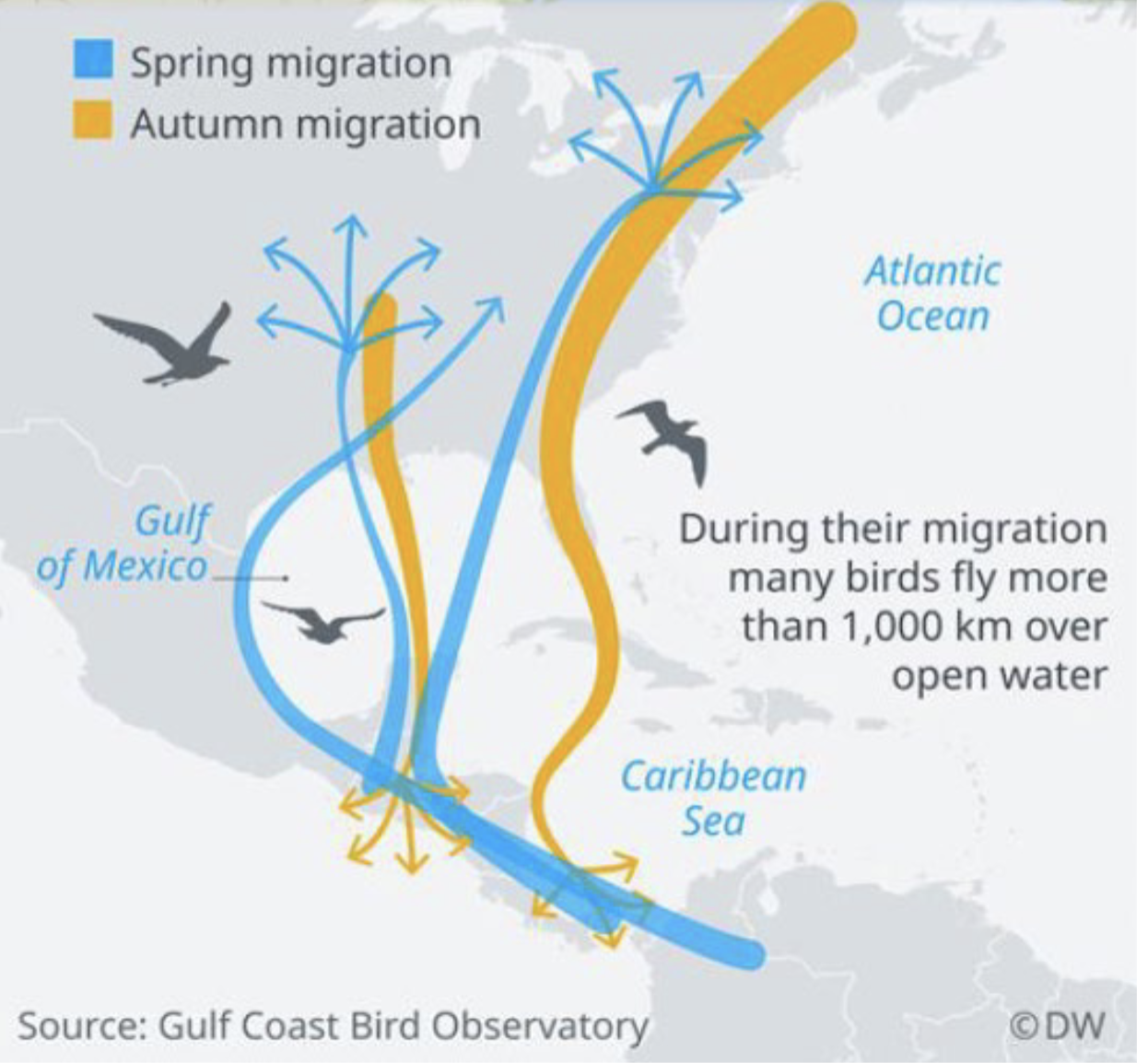
Flyways
Routes used by large numbers of migratory species

Concentration points
Locations along a migratory route where many birds coalesce
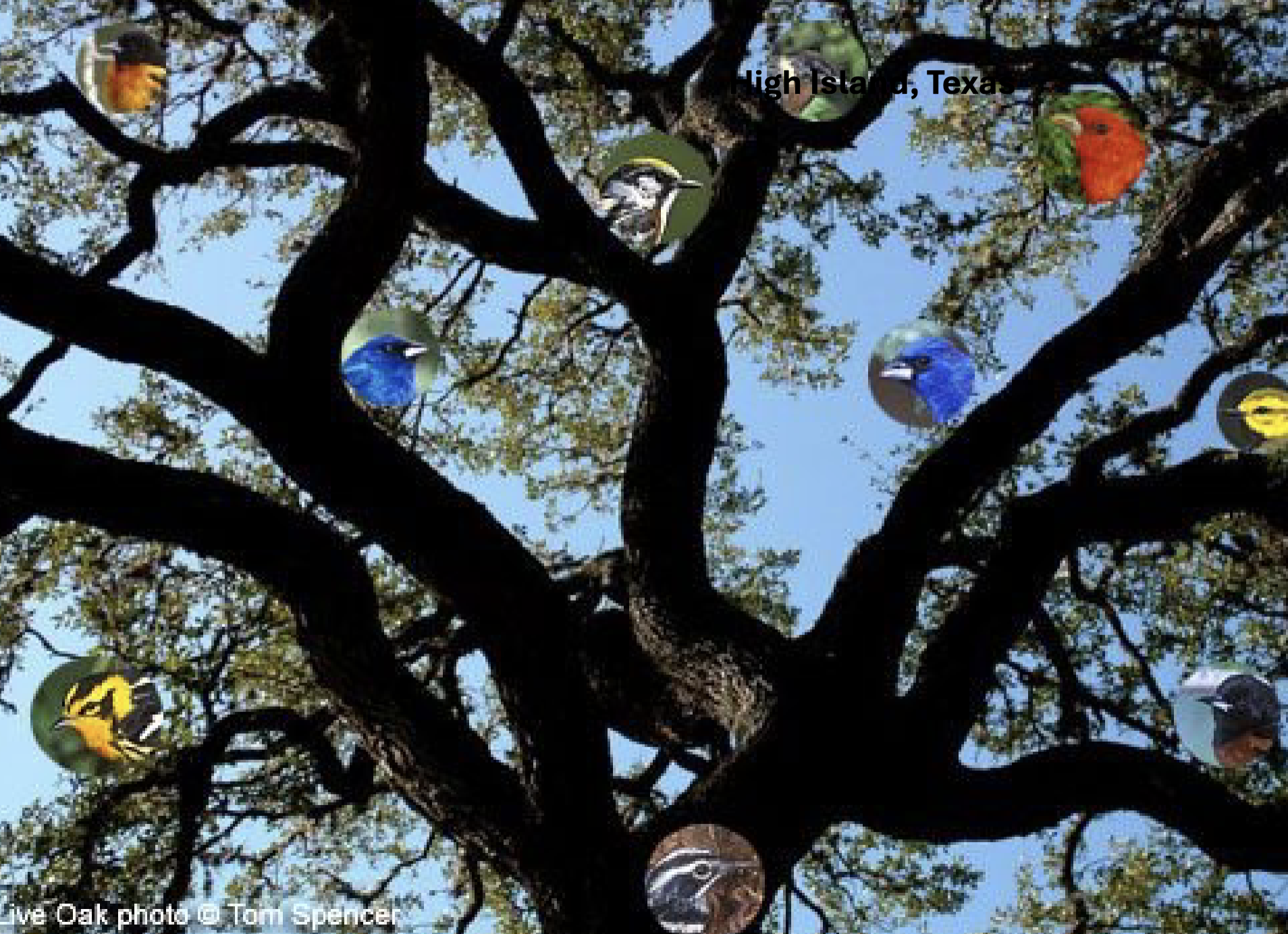
Austral Migration
Very few birds do this given low land mass in far Southern hemisphere
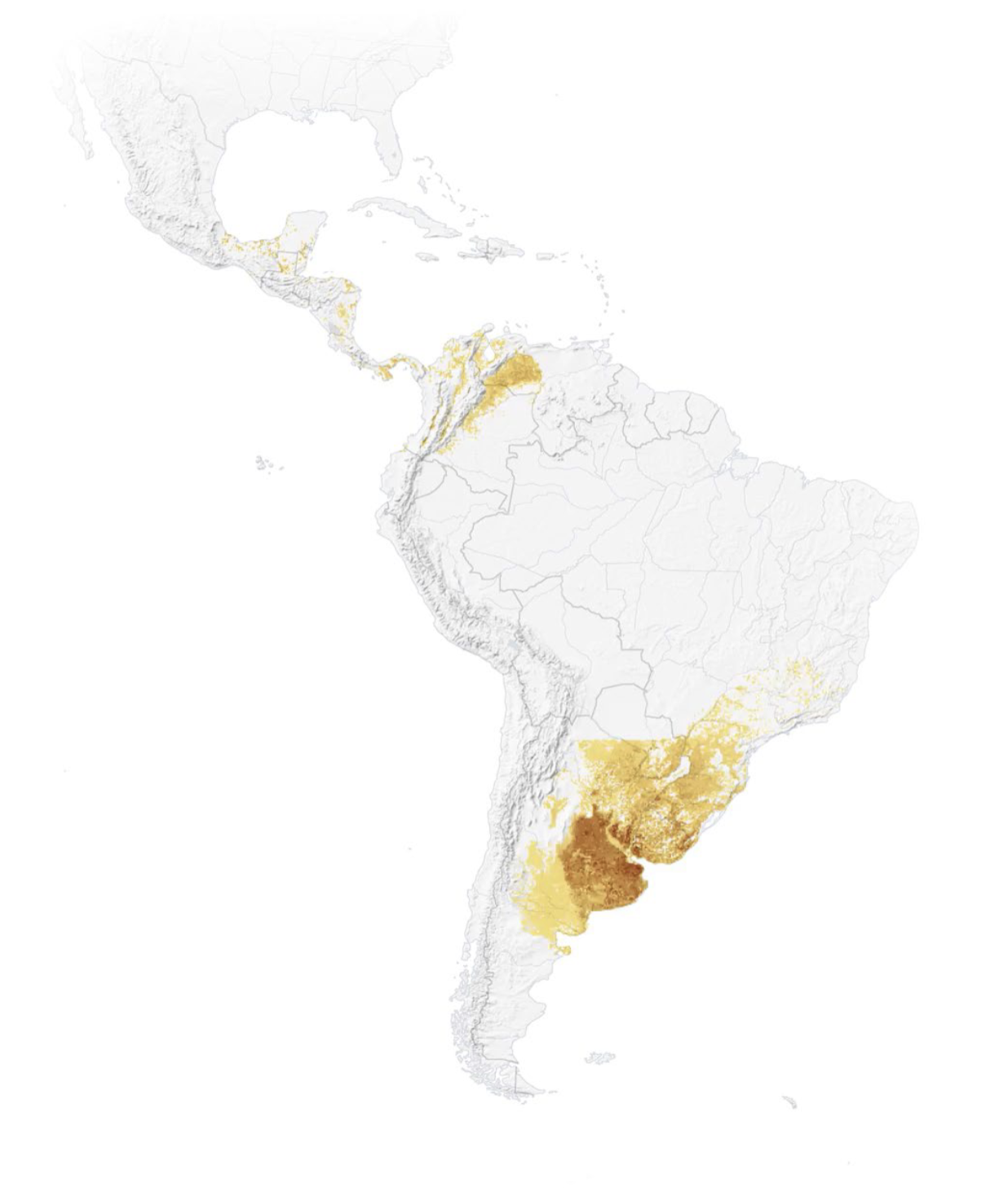
Migration dangers
Habitat loss
Exhaustion/starvation
Severe weather
Collisions
Predation
Illegal hunting/capture
Light pollution/disorientation
Lowest survival on first migrations
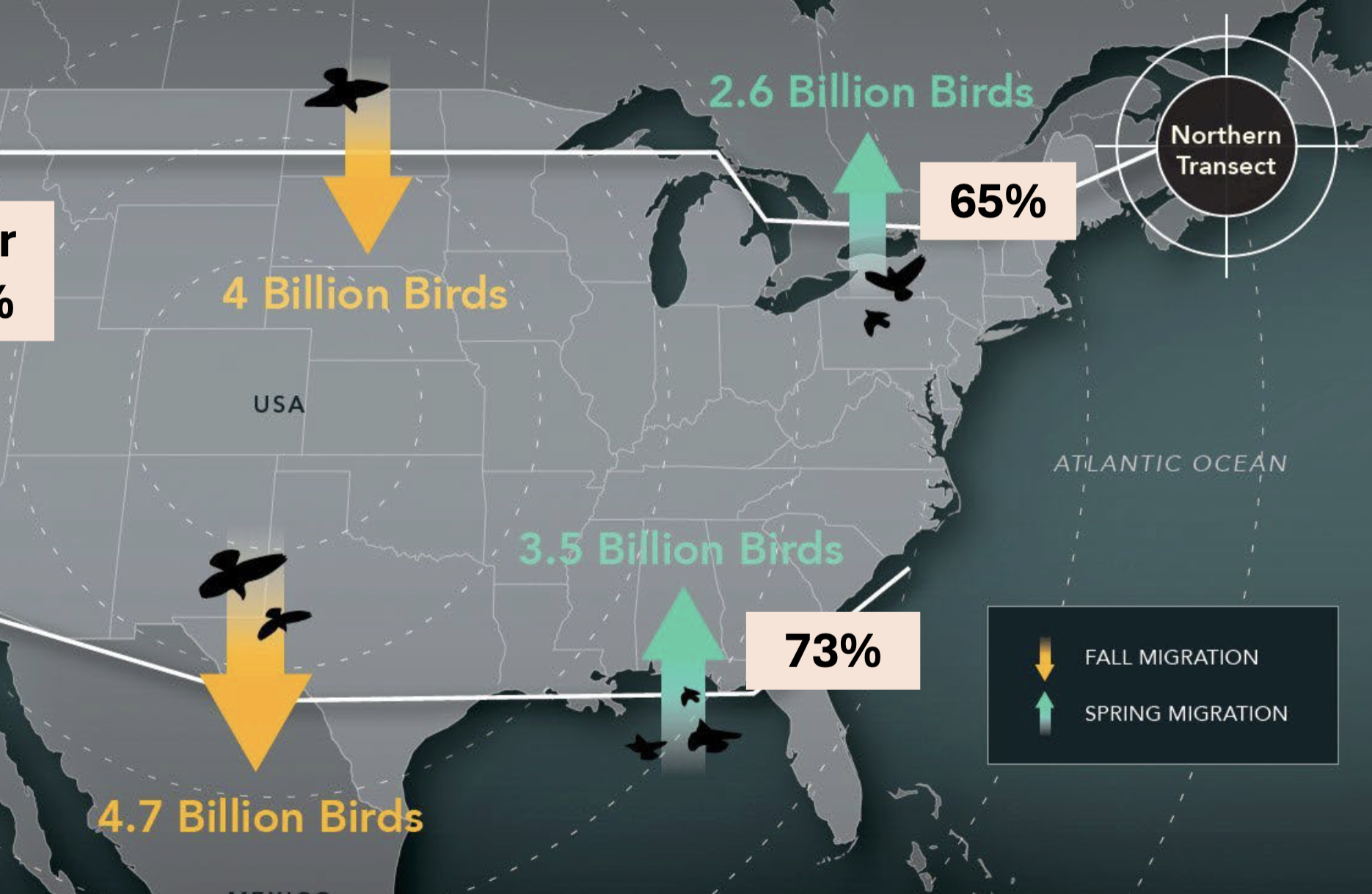
Ecological missmatch due to climate change
Migration timing disrupted by changing environmental conditions and high food availability as temperatures shift

How to track migration?
Banding and recapture
Geolocating devices
MOTUS (big radio towers)
Genetic analysis at breeding and non-breeding sites
Ebird data
Weather radar
